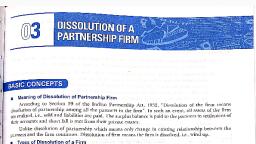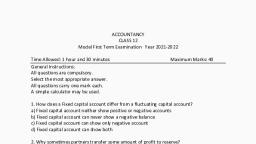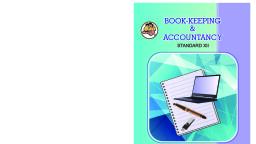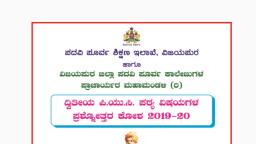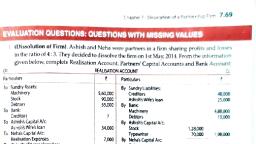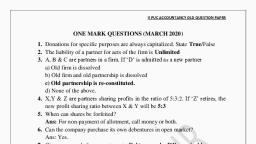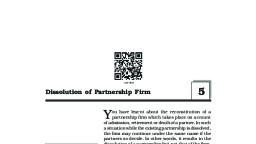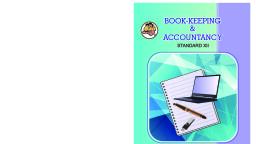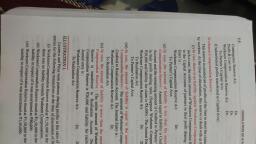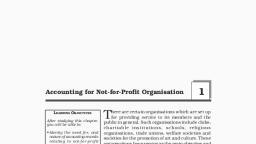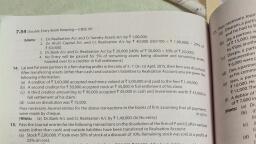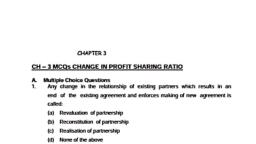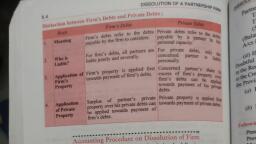Page 1 :
CHAPTER, , 8, , Dissolution of a Partnership Firm, LEARNING OBJECTIVES, , The study of this Chapter would enable students to understand:, Meaning of Dissolution of Partnership Firm, , 8.1, , Modes of Dissolution of a Firm, , 8.1, , Difference between Dissolution of Firm and Dissolution of Partnership, , 8.2, , Settlement of Accounts, , 8.2, , Difference between Firm's Debts and Private Debts, , 8.3, , Accounting on Dissolution of Partnership Firm, , 8.4, , Difference between Revaluation Account and Realisation Account, , 8.20, , MEANING OF DISSOLUTION OF PARTNERSHIP FIRM, Dissolution of firm means business of the firm is discontinued, i.e., closed and the firm is wound, , up, i.e., dissolved. As a result, economic relationship among the partners ends. It is different, , from dissolution of partnership which means change in relationship among the partners but, the firm continues., , According to Section 39 of the Indian Partnership Act, 1932, “Dissolution of the firm means, , dissolution of partnership among all the partners in the firm.” In such an event, all assets of the, firm are realised, i.e., sold and liabilities are paid. The balance, if any, is paid to the partners in, , settlement of their accounts. If there is shortfall in meeting outside liabilities, it is met by the, partners from their private assets., MODES OF DISSOLUTION OF A FIRM, , The modes by which aafirm may be dissolved are:, , 1. By Mutual Agreement: A firm may be dissolved when all the partners agree for its, dissolution., , 2. Compulsory Dissolution: A firm may be compulsorily dissolved:, (a) when all the partners or all the partners except one become insolvent., , (b) when business of the firm becomes unlawful., , 3. By Notice: In case Partnership is at Will, the firm may be dissolved by any partner giving, notice in writing to all the other partners of his intention to dissolve the firm. [Section 43], 4. On Happening of an Event: A firm may be dissolved in any of the following events, if the, Partnership Deed so provides:, , (a) on expiry of the term for which the firm was constituted., (b) on completion of the venture., (, c), on death of a partner., , (d) on adjudication of a partner as insolvent.
Page 2 :
8.2 Double Entry Book Keeping-CBSE XII, , 5. Dissolution by Court: Court may pass order for the dissolution of the firm when:, (a) a partner becomes a person of unsound mind;, , (b) a partner becomes permanently incapable of performing his duties as a partner;, , (c) a partner is found guilty of misconduct, which is likely to adversely affect the business, of the firm;, , (d) partnership agreement is breached persistently by a partner or partners;, (e) court finds dissolution of the firm justified;, , (f) the business of the firm cannot be carried on except at a loss., Difference between Dissolution of Firm and Dissolution of Partnership, Basis, , 1. Meaning, , 2. Court's Intervention, , Dissolution of Partnership, , Dissolution of Firm, , It means closure of the firm and end of It means change in business relationship among, business relationship among all the partners. the partners. The firm continues its business., , It can be either voluntarily by the partners It is always voluntary., , or compulsorily by order of court., 3. Business Continuation Business of the firm comes to an end., , Business of the firm continues., , 4. Closure of Books of, , Books of account of the firm need not be closed., , Books of account of the firm are closed., , Account, 5., , Assets and Liabilities, , Assets of the firm are realised and liabilities Assets of the firm are revalued and liabilities, , are settled. The balance amount, if any, is are reassessed. The gain (profit) or loss due to it,, , distributed among all the partners., , is distributed among the partners in their old, profit-sharing ratio., , 6. Economic Relationship Economic relationship between/among the Economic relationship between/among the, partners ends., partners changes., 7., , Effect, , Dissolution of firm also means dissolution Dissolution of partnership may or may not, of partnership., , involve dissolution of the firm., , SETTLEMENT OF ACCOUNTS, , Generally, two issues have to be resolved at the time of dissolution. These are:, 1. Settlement of Accounts, and, , 2. Payment of Firm's Debts and Private Debts., 1. Settlement of Accounts [Section 48], , Section 48 of the Indian Partnership Act, 1932 deals with the settlement of accounts when the, firm is dissolved. It is discussed below:, , Treatment of Losses: Loss, including deficiencies of capital, is paid first out of profit, then out, of capital and lastly, if necessary, by the partners individually in the ratio in which they share, profits., , [Section 48(a)], , Application of Assets:Assets of the firm, including amount contributed by the partners to make, up deficiencies of capital, are applied in the following order:, , (a) In paying firm's debts to the third parties;, (b) In paying to each partner rateably what is due to him on account of loans or advances;, (c) In paying to each partner rateably what is due to him on account of capital; and, (d) The residue, if any, is distributed among the partners in their profit-sharing ratio., [Section 48(b)]
Page 3 :
Chapter 8. Dissolution of a Partnership Firm 8.3, Illustration 1., , The firm of X, Y and Z was dissolved on 1st April, 2020. Y demands that his loan of 7 25,000, be paid before payment of capitals of the partners. But X and Z demand that capital be paid, before the payment of loan by Y. Who is correct and why?, Solution:, , Y is correct because according to Section 48 of the Indian Partnership Act, 1932, loan by partner, is paid before payment of partners' capitals., Illustration 2., , All the partners decide to dissolve the firm on 1st April, 2020. Y, a partner, demands that, loan of * 80,000 be paid before payment of loan by Mrs. X of 20,000. But X, another partner,, demands that loan by Mrs. X should be paid before repayment of loan by Y. Who is correct, and why?, Solution:, , X is correct because according to Section 48 of the Indian Partnership Act, 1932, outside liabilities, are paid before payment of loan by partner. Mrs. X is not a partner in the firm. Hence, her loan, is to be paid before repayment of loan by Y., Illustration 3, , A and B are partners in a firm sharing profits in the ratio of 3 : 2. Mrs. A has given a loan of, , 20,000 to the firm and the firm had also taken a loan of 10,000 from B. The firm was dissolved, and its assets were realised for * 25,000. State the order of payment of Mrs. A's loan and B's, (Delhi 2010 C), , loan with reason, if there were no other creditors of the firm., Solution:, , According to the Section 48 of the Indian Partnership Act, 1932, Mrs. A's loan of 20,000,, being outside party's debt will be paid before repayment of B's loan. B will be paid up to the, available cash, i.e., *5,000., , 2. Payment of Firm's Debts and Private Debts (Section 49], Debts which the firm owes to outsiders are known as firm's debts, whereas the debts which a partner, , owes in his personal capacity are known as private debts., , Following provisions apply in case of firm's debts and partner's private debts:, 1. Firm's property is applied for payment of firm's debts., 2. Private property of each partner is applied first towards the payment of his private debts and, , surplus, if any, is applied towards payment of firm's debts., Difference between Firm's Debts and Private Debts, Firm's Debts, , Basis, , 1. Meaning, , Firm's debt means the debt owed by the firm Private debt means debt owed by a partner, to outsiders., , 2. Liability, , personally to any other person., , All the partners are liable jointly and severally concerned partner is personally liable for his, for the firm's debts., , 3. Application of, Firm's Property, , Private Debts, , private debts., , Firm's property is applied first for payment Share of the concerned partner in excess of, firm's property over firm's debts can be applied, , of firm's debts., , for payment of private debts., , 4. Application of, , Private Property, , Excess of partner's private property over his Private property is applied first for payment of, , private debts can be applied for payment of private debts then towards firm's liability., firm's debts.
Page 4 :
8.4 Double Entry Book Keeping-CBSE XII, ACCOUNTING ON DISSOLUTION OF PARTNERSHIP FIRM, We had earlier discussed that when a firm is dissolved assets are realised, liabilities are paid and, , the balance, if any, is distributed among the partners.In case of deficiency, shortfall is metby, the partners. It means on dissolution, the books of the firm will have to be closed. Dissolution, process starts by preparing the following accounts in the firm's books:, 1. Realisation Account,, , 2. Loan by Partner Account,, 3. Loan by Firm to Partner Account,, , 4. Partners' Capital Accounts, and, 5. Bank or Cash Account., Let us discuss these in detail., 1. Realisation Account, , Realisation Account is prepared on the dissolution of a firm. The purpose of preparing this, account is to close the books of account of the dissolved firm and to determine gain (profit) or, , loss on the realisation of assets and payment of liabilities. It is prepared by:, , (b, , (i) transferring all assets except fictitious assets, loan to partners and Cash or Bank Account, to the debit side of the account. Fictitious assets being losses are transferred to the debit, side of the Capital Accounts of partners in their profit-sharing ratio., , Loan to a partner is retained in a separate account and is received back from him., , (ii) transferring all liabilities except Partner's Loan Account and Partners' Capital Accounts, to the credit side of the account;, , (iii) amount realised on sale of assets is transferred to the credit of the Account (including, unrecorded assets and assets taken by a partner against capital);, (iv) liabilities paid (including unrecorded liabilities and liabilities assumed by a partner) are, transferred to the debit of the Account; and, , (v) expenses incurred by the firm on dissolution are debited., Balance in the account is either gain (profit) or loss, which is transferred to the Capital Accounts, , of the Partners in their profit-sharing ratio., , Accounting Entries, (i) For Closing the Asset Accounts: All assets (including Goodwill), except fictitious assets,, , Cash in Hand or Balance at Bank*, Current Accounts (Debit Balance)/Capital Accounts (Debit, Balance) of partners and loan to partners are transferred to the Realisation Account at their, book values. As a result, Asset Accounts are closed. The entry is:, Realisation A/C, , ...Dr., , To Various Assets A/C, , (Assets closed by transferring such as Book Debts, Stock, Goodwill, Land, etc.), , Important Points to be kept in mind while transferring Assets to Realisation Account:, (a) Provision or Reserve Against an Asset: When an asset is transferred to the Realisation Account,, , its corresponding provision or reserve existing in the liabilities side of the Balance Sheet, is, *Cash and Bank Accounts are not transferred to Realisation Account as they are already in liquid form., , (r
Page 5 :
Chapter 8 . Dissolution of a Partnership Firm 8.5, also transferred to Realisation Account. For example, Investments exist in the assets side, of the Balance Sheet and Investments Fluctuation Reserve exists in the liabilities side of, the Balance Sheet. The entries passed are:, (a) Realisation A/C, , ...Dr., , To Investments A/C, , (b) Investments Fluctuation Reserve A/C, , ...Dr., , To Realisation A/C, , Another example is, if Debtors in the Balance Sheet exist at * 50,000 and Provision for, , Doubtful Debts at 5,000; 350,000 (gross amount of Debtors) is transferred to the debit side, , of Realisation Account and 35,000 (amount of Provision for Doubtful Debts) is transferred, to its credit side. The entries are:, ...Dr., , (a) Realisation A/C, , 50,000, 50,000, , To Debtors A/C, ...Dr., , (b) Provision for Doubtful Debts A/C, , *5,000, , 5,000, , To Realisation A/C, , (b) Fictitious Assets: Balance of fictitious assets such as accumulated losses, deferred revenue, , expenditure (e.g., Advertisement Suspense A/c), etc., are not transferred to Realisation, Account. These accounts are transferred to the Capital Accounts of Partners in their profit, sharing ratio by passing the following entry:, Partners' Capital A/cs, To Profit and Loss A/C (Dr. Balance), , ...Dr., , To Deferred Revenue Expenditure (Advertisement Suspense) A/C, , (c) Current Accounts of Partners: Balances in Current Accounts (Debit or Credit) of partners, are transferred to their Capital Accounts. The entry for Current Accounts with Debit, Balance is:, , Partner's Capital A/C, To Partner's Current A/C, , ...Dr., , The entry for Current Account with Credit Balance is:, Partner's Current A/C, , ...Dr., , To Partner's Capital A/C, , a result, Current Accounts., will close, As, , (d) Loan to a Partner: Balance in the Loan to a Partner Account is transferred to the debit of his, , Capital Account. It is, thus, recovered from his Capital Account. The entry passed is:, Partner's Capital A/C, To Loan to Partner A/C, , ...Dr., , (ii) For Closing the Liabilities Accounts: Liabilities (relating to third parties, i.e., liabilities, to outsiders) are transferred to Realisation Account at their book values by passing the, , following entry:, Sundry Creditors A/C, Bills Payable A/C, , ...Dr., , Bank Loan A/c, Loan from third parties, etc., , ...Dr., , To Realisation A/C, , ...Dr.
Page 6 :
8.6 Double Entry Book Keeping-CBSE XII, Liabilities to outsiders means liabilities which the firm has to pay to outsiders such as, , creditors, bills payable, bank overdrafts, employees' provident fund, loan of partner's, spouse, etc., , Important Points to keep in mind while transferring liabilities to Realisation Account:, (a) Liabilities to third parties do not include accumulated profits, e.g., reserve, credit balance, of Profit and Loss Account, etc., Hence, these accounts are not transferred to Realisation, , Account but are transferred to Capital Accounts of the partners;, (b) Loan by Partners Accounts, i.e., loan by partners are not transferred to Realisation Account., Loan by Partners Accounts are kept and paid separately. It is so because loan by partner is to, be paid after payment of outside liabilities but before payment of capitals; and, (c) Liabilities due to partners (i.e., Capital and Current Accounts of Partners) are also not, liabilities to outsiders and are not transferred to Realisation Account., , Workmen Compensation Reserve, Workmen Compensation Reserve is a reserve set aside out of profits to meet claims of, , compensation by workmen, if it arises. At the time of dissolution any of the following situation, may exist which are dealt with as explained below:, (a) Liability against Workmen Compensation Reserve does not Exist or No Information is given, of liability for Workmen Compensation: In such a case, it is presumed that liability for Workmen, , Compensation does not exist, i.e., is nil. Therefore, the amount of Workmen Compensation, Reserve is distributed among the partners in their profit-sharing ratio. The Journal entry is:, Workmen Compensation Reserve A/C, , ...Dr., , To Partners' Capital A/cs, , (b) Liability of Workmen Compensation is less than the Amount of Workmen Compensation, Reserve: Amount equal to liability is transferred (credited) to Realisation Account and, the balance amount of Workmen Compensation Reserve is transferred (credited) to, , Capital Accounts of partners in their profit-sharing ratio. The Journal entry is:, Workmen Compensation Reserve A/C, , ...Dr., , [With the amount of Liability], , To Realisation A/C, , To Partners' Capital A/cs, , (c) Liability of Workmen Compensation is equal to the Amount of Workmen Compensation Reserve: The, total amount of Workmen Compensation Reserve is transferred (credited) to Realisation, Account. The Journal entry is:, , Workmen Compensation Reserve A/C, , ...Dr., , To Realisation A/C, , (d) Liability ofWorkmen Compensation is more than the Amount ofWorkmen Compensation Reserve: The, total amount of Workmen Compensation Reserve is transferred (credited) to Realisation, Account. The Journal entry is:, Workmen Compensation Reserve A/C, To Realisation A/C, , ...Dr.
Page 7 :
Chapter 8 · Dissolution of a Partnership Firm 8.7, Illustration 4., , Shiv and Mohan were partners sharing profits in the ratio of 3 : 2. Give Journal entries under, following situation at the time of dissolution of firm:, (i) Workmen Compensation Reserve in the Balance Sheet was * 75,000., (ii) Workmen Compensation Reserve was 60,000 and liability for it was * 35,000., (iii) Workmen Compensation Reserve was 7 60,000 and liability was 75,000., (iv) Workmen Compensation Reserve was 760,000 and liability was 60,000., , (v) Workmen Compensation Reserve was nil and liability was * 15,000., Solution:, Date, , (0), , JOURNAL, L.F., , Particulars, , Workmen Compensation Reserve A/C, To Shiv's Capital A/C, To Mohan's Capital A/C, , ...Dr., , Dr. (), , Cr. (1), , 75,000, 45,000, , 30,000, , (Balance of Workmen Compensation Reserve transferred to Partners', Capital Accounts in the profit-sharing ratio), , Note: Since, amount of liability is not given, it is assumed to be nil., ) (a) Workmen Compensation Reserve A/C, (ii, , ...Dr., , 35,000, 35,000, , To Realisation A/C, , (Workmen Compensation Reserve the extent of liability transferred to, Realisation Account), , (b) Workmen Compensation Reserve A/C, , ...Dr., , 25,000, 15,000, , To Shiv's Capital A/C, , 10,000, , To Mohan's Capital A/c, , (Surplus ofWorkmen Compensation Reserve transferred, , to Partners' CapitalAccounts in their profit-sharing ratio), (c) Realisation A/C, , ...Dr., , 35,000, 35,000, , To Bank A/C, , (Liability on account of Workmen Compensation paid), ...Dr., , 60,000, , (, , iii) (a) Workmen Compensation Reserve A/c, To, , 60,000, , Realisation A/C, , (Balance of Workmen Compensation Reserve transferred to, Realisation Account), (b) Realisation A/C, To, , ...Dr., , 75,000, , 75,000, , Bank A/C, , (Liability on account of workmen compensation paid), (iv) (a) Workmen Compensation Reserve A/C, To, , ...Dr., , 60,000, , 60,000, , Realisation A/C, , (Balance of Workmen Compensation Reserve transferred to, Realisation Account), (b) Realisation A/C, , ...Dr., , 60,000, 60,000, , To Bank A/C, , (Liability on account of Workmen Compensation paid), (v), , Realisation A/C, To, , Bank A/C, , (Liability on account ofWorkmen Compensation paid), , ...Dr., , 15,000, 15,000
Page 8 :
8.8 Double Entry Book Keeping-CBSE XII, ACCOUNTING OF UNRECORDED ASSETS AND LIABILITIES, Unrecorded assets and liabilities are the assets and liabilities which exist but are not shown in the, , books of account. This may be because of either they were written off or omitted to be accounted., Since they are not recorded, these assets and liabilities are not transferred to Realisation Account., , Following accounting procedure is followed:, • When amount is realised from sale of unrecorded asset, it is debited to Cash/Bank Account, , and credited to Realisation Account, it being in the nature of gain., • When unrecorded asset is taken by partners, it is debited to concerned Partner's Capital, Account and credited to Realisation Account., , When unrecorded liability is paid, Realisation Account is debited and Cash/Bank Account is, , credited with the amount paid, it being in the nature of loss., , • When a partner pays unrecorded liability, Realisation Account is debited and concerned, Partner's Capital Account is credited., , Entry is not passed, if unrecorded asset is given against a recorded or unrecorded liability., (iii) For Realisation of Assets (whether Recorded or Unrecorded):, Mode ofRealisation, 1., , When the assets are sold for cash., , Accounting Entry, ...Dr., , Cash (or Bank) A/C, , (With the realised, amount), , To Realisation A/C, , 2. When an asset is taken by a partner., , Concerned Partner's Capital A/C, , ...Dr., , (With agreed price), , To Realisation A/C, , 3., , When an asset is given to creditor, , No entry is passed, , towards payment of his dues., (iv) For Settlement of Liabilities (whether Recorded or Unrecorded):, Mode ofSettlement, , 1., , On payment of liabilities., , Accounting Entry, Realisation A/C, , ...Dr., , To Cash/Bank A/C, , 2., , If a partner agrees to settle a liability., , Realisation A/C, , ...Dr., , To Concerned Partner's Capital A/c, , Points to Remember: Realisation of Assets and Settlement of Liabilities, If question is silent about:, , 1. the realisation of Tangible Asset(s) like furniture, vehicle, debtors, etc., it is assumed that, such assets have not realised any amount., , 2. settlement of any liability, it is assumed that amount equal to book value is paid., , Note: As per CBSE Guidelines, the realised value of asset should be given., Transfer of Assets to Settle Liabilities: A creditor, or any person to whom amount is due, may, , accept an asset in part or full settlement of his claim. In such a case, entry is not passed for the, amount of asset to record the settlement of liability because the assets and liabilities are already, , transferred to the Realisation Account. If an asset is given to a creditor in part payment of his, , due, then the balance amount, i.e., amount after adjusting the agreed value of asset taken by, , creditor, paid to him, is debited to the Realisation Account and credited to Bank Account. For, example, if the amount due to a creditor is 25,000 and he takes stock of the book value of, 20,000 at * 18,000 and balance in cash, following entry is passed:, Realisation A/C, , To Cash/Bank A/C, , ...Dr., , 7,000, *7,000
Page 9 :
Chapter 8 . Dissolution of a Partnership Firm 8.9, Illustration 5., , Pass Journal entries for following transactions on dissolution of a firm of partners Mohan and, , Sohan, after various assets (other than cash) and outside liabilities have been transferred to, Realisation Account?, , (i) 'Mohan' took 50% of the stock at a discount of 20%. Remaining stock was sold at a profit, of 30% on cost. (Book value of stock given in the Balance Sheet before dissolution was 7 4,00,000)., (ii) Debtors * 2,64,000. Provision for Doubtful Debts: 24,000, * 48,000 of the book debts, proved bad., , (i) Building (Book value 5,00,000) sold for 3 8,00,000 through a broker who charged 2%, commission,, , (iv) Machinery (Book value * 6,00,000) was given to a creditor at a discount of 20% in settlement., (v) Investments (Book value 40,000) realised at 150%., JOURNAL, , Solution:, , L.F., , Particulars, , (1) (a) Mohan's Capital A/c [ 4,00,000 x 50/100) - (20/100 x 2,00,000)], To, , Dr. () Cr. (), , ...D., , 1,60,000, , ...Dr., , 2,60,000, , 1,60,000, , r, , Date, , Realisation A/C, , (50% of stock taken by Mohan at a discount of 20%), (b) Bank A/c [ 4,00,000 x 50/100) + (30% of 2,00,000)], To, , 2,60,000, , Realisation A/C, , (Balance stock realised at a profit of 30%), Bank A/C * 2,64,000 - 48,000), To, , ...Dr., , 2,16,000, , 2,16,000, , Realisation A/C, , (Debtors realised), Bank A/c*, , To, , ...Dr., , 7,84,000, 7,84,000, , Realisation A/C, , (Building realised, commission paid), , (iv), , No Journal entry (if an asset (recorded or unrecorded) is given in, settlement of a liability (recorded or unrecorded), no entry, is passed.], , ), , Bank A/C 40,000 x 150/100), To, , ...Dr., , 60,000, 60,000, , Realisation A/C, , (Investments realised), , *Alternatively, Realisation Account be credited with value realised (8,00,000) and thereafter Realisation Account be debited, with commission paid ( 16,000)., , Illustration 6., , Adiraj and Karan were partners in a firm sharing profits and losses in the ratio 3 : 2. On, :, , 31st March, 2018 the firm was dissolved. After the transfer of assets (other than cash in hand, , and at bank) and third party liabilities to the Realisation Account, the following information, was provided:, (i) Furniture of 70,000 was sold for * 68,000 by auction and auctioneer's commission, amounted to * 2,000., , (ii) Adiraj's loan amounting to 35,000 was paid., , (iii) Out of the stock of 80,000, Karan took over 50% of the stock at a discount of 20% while, , the remaining stock was sold off at a profit of 30% on cost.
Page 10 :
8.10 Double Entry Book Keeping-CBSE XII, , (iv) A bills receivable of 3,000 under discount was dishonoured as the acceptor had become, insolvent and hence the bill had to be met by the firm., (v) Profit and Loss Account showed a debit balance of 56,000., (vi) Realisation expenses amounted to * 2,000 which were paid by Adiraj., Pass the necessary Journal entries for the above transactions on the dissolution of the firm., (CBSE 2015), , Solution:, , In the Books of the Adiraj and Karan, JOURNAL, , Date, , Particulars, , L.F., , Dr.), , G.RO, , 2018, , March 31 Bank A/C, (i), , To, , ...Dr., , 66,000, , Realisation A/C, , 66,000, , (Furniture realised), (ii) Adiraj's Loan A/C, , ...Dr., , 35,000, , To Bank A/C, , 35,000, , (Partner's loan settled), , (iii) Karan's Capital A/C, To, , ...Dr., , 32,000, , Realisation A/C, , 32,000, , (Half of the stock taken over by Karan), Bank A/C, , ...Dr., , 52,000, , To Realisation A/C 40,000 + 30% of 40,000), , 52,000, , (Remaining stock sold at 30% profit), (iv) Realisation A/C, , ...Dr., , 3,000, , To Bank A/C, , 3.000, , (Liability on account of dishonoured Bill met), (v) Adiraj's Capital A/C, , ...Dr., , Karan's Capital A/C, , 33,600, , ...Dr., , 22,400, , To, , Profit and Loss A/C, , 56,000, , (Debit balance of Profit and Loss Account debited to, Partners' Capital Accounts), (vi) Realisation A/C, , To Adiraj's Capital A/C, , ...Dr., , 2,000, 2,000, , (Realisation expenses paid by Adiraj), Illustration 7., , What Journal entries will be passed for the following transactions on the dissolution of a firm, of partners A and B:, , (i) Old furniture which had been written off in the books was sold for $20,000., (ii) 'Z' an old customer whose account for 10,000 was written off as bad debt in the previous, year, paid 70%., , (iii) ‘A’ agreed to takeover firm's goodwill (Not recorded in the books of a firm) at * 50,000., (iv) There was an old computer which had been written off from the books. It was estimated, to realise 5,000. It is taken by ‘B' a partner at the estimated price less 30%., (v) Investments costing * 20,000 (being 1,000 shares), had been written off from the books, , These investments (shares) are valued @ 15 each and distributed between the partners, in their profit-sharing ratio.
Page 11 :
Chapter 8 . Dissolution of a Partnership Firm 8.11, :, SolutionJOURNAL, Date, 0, , Particulars, , L.F., , Bank A/C, To, , ...Dr., , Dr. (*), , Cr. (3), , 20,000, 20,000, , Realisation Alc, , (Furniture not existing in the Books sold), Bank A/C, To, , ...Dr., , 7,000, 7,000, , Realisation A/C, , (Debt written off now received), A's Capital A/C, To, , ...Dr., , 50,000, 50,000, , Realisation A/C, , (Unrecorded goodwill taken by A), (iv), , ...Dr., , B's Capital A/C, To, , 3,500, 3,500, , Realisation A/C, , (Computer written off taken by B), (V), , A's Capital A/C, B's Capital A/C, To, , ...Dr., , 7,500, , ...Dr., , 7,500, 15,000, , Realisation A/C, , (Investments (shares) written off taken by A and B, in their profit-sharing ratio), , (v) For Realisation Expenses: Realisation Expenses or Dissolution expenses are incurred in, , dissolving the firm by selling the assets and paying the liabilities. These expenses may be paid, as remuneration (salary) to a partner to carry out dissolution and/or as expenses incurred. These, being the expenses for dissolution of the firm are debited to Realisation Account. Realisation, , expenses may either be paid or may be credited to the Concerned Partner's Capital Account., The possible circumstances of Realisation Expenses are as follows:, (a) A partner is paid remuneration (salary) and realisation expenses are borne by the firm;, (b) A partner is paid remuneration (salary) and also agreed amount as realisation expenses;, (c) A partner is paid fixed amount including realisation expenses., Let us discuss these elaborately., , (a) A Partner is paid Remuneration (salary) and Realisation Expenses are borne by the Firm:, Remuneration means payment for the services rendered by the partner to complete the, dissolution. It does not include realisation expenses incurred in completing the process. In, , such a situation, realisation expenses are borne by the firm, besides the remuneration, payable to the partner., , Thus, if a partner is paid remuneration (salary) and realisation expenses are borne by the firm,, Realisation Account is debited with the amount of remuneration and realisation expenses., Realisation expenses incurred may be paid by the firm or by any of the partners., The Journal entries are as follows:, For Remuneration (salary) to a partner:, , Realisation A/C, , To Concerned Partner's Capital A/C, (Remuneration or Salary credited to Partner's, , Capital Account), , ...Dr.
Page 12 :
8.12 Double Entry Book Keeping—CBSE XII, For Realisation Expenses borne and paid, by the Firm:, , ...Dr., , Realisation A/C, To Cash/Bank A/C, , (Realisation expenses paid by the firm), , For Realisation Expenses borne by the firm, but paid by a partner:, , ...Dr., , Realisation A/C, , To Concerned Partner's Capital A/C, (Realisation expenses paid by the, , partner credited to his Capital Account), , For Realisation Expenses borne by the firm, but partly paid by the firm and balance by, a partner:, , ...Dr., , Realisation A/C, , (Amount paid by the firm], , To Cash/Bank A/C, , (Amount paid by the partner], , To Concerned Partner's Capital A/C, , (Realisation expenses paid by the, partner credited to his Capital Account), , (b) A Partner is paid Remuneration (salary) and also Agreed Amount as Realisation Expenses: A, partner may be paid remuneration (salary) and also agreed amount to meet the realisation, , expenses. It means the firm has to pay the agreed amount whether the realisation expenses, are more or less than the agreed amount., , Thus, in this situation, firm is liable to pay remuneration (salary) to the partner and also the, agreed amount for expenses. Realisation Account is debited by the amount of remuneration, , (salary) and agreed amount of realisation expenses. The Journal entry is as follows:, For Remuneration and Realisation Expenses Payable to a Partner:, Realisation A/C, , ...Dr., , To Concerned Partner's Capital A/C, , (Remuneration and realisation expenses payable to partner), , Further, realisation expenses may be paid by the partner or by the firm. In case, the, , information as to payment of realisation expenses is not given and the partner is to bear, the realisation expenses, it is presumed that the partner who was to bear the realisation, , expense has paid it. In case, the firm pays the realisation expenses, it means that the firm, has paid the expenses on behalf of the partner. Thus, amount so paid by the firm is debited, to the Concerned Partner's Capital Account., , For Realisation Expenses paid by the Firm on behalf of the Partner:, Concerned Partner's Capital Alc, , ...Dr., , To Cash/Bank A/C, , (Realisation expenses paid on behalf of the partner), , For Realisation Expenses paid by the partner carrying out the dissolution process:, Concerned Partner's Capital Account is credited with the agreed amount of realisation, , expenses payable to him. If the concerned partner has paid the realisation expenses, further, entry is not passed since he was to bear the realisation expenses., (c) A Partner is paid Fixed Amount that includes Realisation Expenses:, , partner may be paid fixed, , amount that includes remuneration and realisation expenses. It means that the firm has, , agreed to pay fixed amount and does not have to bear further expenses besides the agreed, amount. Therefore, in this situation, firm is liable to pay the agreed amount to the partner., Therefore, Realisation Account is debited by the agreed amount payable to the partner and, , credited to the Concerned Partner's Capital Account.
Page 13 :
Chapter 8 . Dissolution of a Partnership Firm 8.13, The Journal entry is as follows:, , For the Fixed Amount Payable to Partner:, Realisation A/C, , ...Dr., , To Concerned Partner's Capital A/C, , (Amount including realisation expenses, payable to the partner credited to his Capital Account), , In case the firm pays amount towards realisation expenses, it is on behalf of the partner., , The amount so paid is debited to that Partner's Capital Account., , For Realisation Expenses paid by the firm on behalf of the Partner:, ... Dr., , Concerned Partner's Capital A/c, To Cash/Bank A/C, , (Realisation expenses paid on behalf of the partner), , For Realisation Expenses paid by the partner carrying out the dissolution process:, Capital Account of the partner is credited with the agreed amount payable to him. Thus ,, , if the concerned partner has paid the realisation expenses, entry is not passed for it., JOURNAL ENTRIES ON PAYMENT OF REALISATION EXPENSES, , Mode of Payment, 1. When realisation expenses are borne and also paid, by the firm., 2. When realisation expenses were to be borne, , by the firm but are paid by a partner., , 3. When realisation expenses are borne and paid, , Accounting Entry, Realisation A/C, , ...Dr., , To Cash/Bank A/C, Realisation A/C, , ...Dr., , To Concerned Partner's Capital A/C, , No Entry, , by the same partner., , 4. When any of the partners agrees to carry out, dissolution for an agreed remuneration, including, , Realisation A/C, , ...Dr., , To Concerned Partner's Capital A/C, , realisation expenses, 5. When realisation expenses are borne by a partner, and paid by the firm., , Concerned Partner's Capital A/c, , ...Dr., , To Cash/Bank A/C, , Illustration 8., , Pass Journal entries for the following transactions:, (i) Realisation expenses were 10,000., (ii) Realisation expenses of 5,000 were paid by Taran, a partner., , (iii) Realisation expenses of # 5,000 were paid by the firm on behalf of Madan, a partner., (iv) Pawan, a partner was paid remuneration (including expenses) of $20,000 to carry out, dissolution of the firm. Actual expenses were 10,000., (v) Dissolution expenses were 8,000. Out of the said expenses, 73,000 were to be borne by, the firm and the balance by Ravi, a partner. 8,000 are paid by the firm.
Page 14 :
8.14 Double Entry Book Keeping-CBSE XII, , (vi) Realisation expenses of 35,000 were to be borne and paid by Karan, a partner., (vii) Manoj, a partner is to carry out dissolution of the firm at an agreed remuneration of, * 10,000., , (viii) Dev, a partner, is paid remuneration of 15,000 for dissolution of the firm. Realisation, expenses of 8,000 are paid by the firm., , (ix) Realisation expenses of * 5,000 were to be borne by Pavit, a partner. However, it was, paid by Hitesh, another partner. It was to be recorded in the books., Solution:, Date, , (i), , JOURNAL, , Particulars, , Realisation A/C, To, , L.F., , ...Dr., , Dr., , Cr., , ₹, , ₹, , 10,000, , Cash/Bank A/C, , 10,000, , (Dissolution expenses paid), Explanation: The expenses of dissolution are borne and paid by the firm,, , since the question does not specify who is to bear the dissolution expenses., (ii), , Realisation A/C, , ...Dr., , 5,000, , To Taran's Capital A/C, (Dissolution expenses paid by the partner credited, , 5,000, , to his Capital Account), , Explanation: The expenses of dissolution are borne by the firm, , but paid by the partner on behalf of the firm. Therefore,, Taran's Capital Account is credited., (iii), , Madan's Capital A/C, To, , ...Dr., , 5,000, , Cash/Bank A/C, , 5,000, , (Dissolution expenses paid by the firm on behalf, of the partner debited to his Capital Account), Explanation: The expenses of dissolution are borne by the partner, but are paid by the firm. Therefore, Madan's Capital Account is debited., (iv), , Realisation A/C, , ...Dr., , 20,000, , To Pawan's Capital A/c, , 20,000, , (Remuneration to partner credited to his Capital Account), , Explanation: It is agreed to pay the partner $20,000 towards his remuneration, and expenses of dissolution. Actual expenses are not relevant for the firm., v, (v), , Realisation A/C, , ..., Dr., , 3,000, , Ravi's Capital A/C, , Dr., ..., , 5,000, , To, , Cash/Bank A/C, , (Dissolution expenses paid by the firm, firm's share, of expenses debited to Realisation Account and balance to, Ravi's Capital Account), , Explanation: Total expenses of dissolution are 8,000. Out of this,, , 3,000 is to be borne by the firm and balance 5,000 by the partner., Therefore, 3,000 is debited to Realisation Account. Balance 5,000 is, debited to Ravi's Capital Account., , 8,000
Page 15 :
Chapter 8 . Dissolution of a Partnership Firm 8.15, (vi), , No entry is to be passed., Explanation: Entry for expenses of dissolution will not be passed because, , the expenses ( 5,000) are borne and also paid by Karan, the partner., (vii), , Realisation A/C, , ...Dr., , 10,000, , 10,000, , To Manoj's Capital A/C, , (Remuneration payable to Manoj, a partner), (viii) (a), , A/C, , RealisationTo Dev's Capital A/C, , ...Dr., , 15,000, 15,000, , (Remuneration payable to Dev for dissolution of the firm), (b) Realisation A/C, , ...Dr., , 8,000, 8,000, , To Cash/Bank A/C, , (Realisation expenses paid), Explanation: Dev, the partner, is paid $ 15,000 as remuneration for, dissolution of the firm. The expenses of dissolution are met by, , the firm. Therefore, Dev's Capital A/c is credited with # 15,000 (remuneration), and 8,000 being expenses borne and paid by the firm is debited to, Realisation Account and credited to Cash/Bank A/c., (ix), , Pavit's Capital A/C, , ...Dr., , 5,000, , To Hitesh's Capital A/C, , 5,000, , (Realisation expenses to be borne by Pavit, paid by Hitesh), Illustration 9, , Pass necessary Journal entries on the dissolution of a partnership firm in the following cases:, (i) L, a partner, was appointed to look after the dissolution process for which he was given, remuneration of 10,000., , (ii) Dissolution expenses * 8,000 were paid by the partner, M., (ii) Dissolution expenses were 5,000., , (iv) P, a partner, was appointed to look after the process of dissolution for which he was, allowed a remuneration of 7,000. P agreed to bear the dissolution expenses. Actual, , dissolution expenses * 4,000 were paid by P., (v) N, a partner, was appointed to look after the process of dissolution for which he was, allowed a remuneration of * 9,000. N agreed to bear the dissolution expenses. Actual, dissolution expenses ₹4,000 were paid by the firm., (vi) Q, a partner, was appointed to look after the process of dissolution for which he was, allowed a remuneration of 18,000. Q agreed to take over stock worth 18,000 as his, remuneration. The stock had already been transferred to Realisation Account., , (Delhi 2017)
Page 16 :
8.16 Double Entry Book Keeping-CBSE XII, Solution:, , JOURNAL, , Particulars, , Date, , (i), , L.F., , Realisation A/C, , ...Dr., , Dr.), , Cr. (*), , 10,000, , To L's Capital A/C, , 10,000, , (Remuneration provided to L), (ii), , Realisation A/C, , ...Dr., , 8,000, , To M's Capital A/C, , 8,000, , (Dissolution expenses payable to M), Realisation A/C, , ...Dr., , 5,000, , To Bank/Cash A/C, , 5,000, , (Realisation expenses paid), (iv), , Realisation A/C, , ...Dr., , 7,000, , To P's Capital A/C, , 7,000, , (Remuneration allowed to Pand dissolution expenses, paid by him), (v) (a) Realisation A/C, , ...Dr., , 9,000, , To N's Capital A/C, , 9,000, , (Remuneration paid to N), (b) N's Capital A/C, , ...Dr., , 4,000, , To Cash/Bank A/C, , 4,000, , (Dissolution expenses paid by firm on behalf of N), (vi), , No Entry: Neither for remuneration for dissolution, nor for, stock taken over., , or, Alternatively, (a) Realisation A/C, , ...Dr., , 18,000, 18,000, , To Q's Capital A/C, , (Remuneration allowed to Q), (b) Q's Capital A/C, To, , ...Dr., , Realisation A/c, , 18,000, 18,000, , (Stock taken by Q as remuneration), , (vi) For Closing Realisation Account: Realisation Account at this stage shows either gain, , (profit) (if the total of the credit side is more than the total of debit side, i.e., if it has aa credit, balance) or loss (if the total of the debit side is more than the total of credit side, i.e., if it has a, debit balance). The gain (profit) or loss is transferred to the Capital Accounts of the Partners, , in their profit-sharing ratio., When there is a Gain (Profit) on Realisation, the entry is:, Realisation A/C, , ...Dr., , [In old profit-sharing ratio), , To Partners' Capital A/cs, , When there is a Loss on Realisation, the entry is:, Partners' Capital A/cs, To Realisation A/C, , ...Dr., , [In old profit-sharing ratio)
Page 17 :
Chapter 8 . Dissolution of a Partnership Firm 8.17, Specimen of Realisation Account, Dr., , Cr., , REALISATION ACCOUNT, , Particulars, , ₹, , To Land and Building A/c, , By Provision for Doubtful Debts A/C, , To Plant and Machinery A/C, , By Investment Fluctuation Reserve A/C, By Sundry Creditors A/C, By Bills Payable A/C, , To Furniture A/C, To Stock A/c, To Debtors A/C, 00, , Goodwill A/C, To, , ₹, , Particulars, , By Outstanding Expenses A/c, , By Bank Loan, Bank Overdraft, Cash Credit A/c, , Investment A/C, , 8., , To Bank/Cash A/c (Liabilities Paid):, , By Bank/Cash A/c (Assets Realised):, Land and Building, , Sundry Creditors, Bills Payable, Outstanding Expenses, Bank Loan, Overdraft, Cash Credit, , .., , Plant and Machinery, Furniture, , Stock, , 3, , Debtors, Bad Debts Recovered, , ., , To Bank/Cash A/c (Realisation Expenses), To Partner's Capital A/c (Say X), (Realisation Expenses), , By Partners' Capital A/cs (Assets Taken), , To Partners' Capital A/cs, , By Partners' Capital A/cs, , ..., , ..., , GE, , Investment, , (Gain (Profit) on Realisation)*:, , .., , .., , (Loss on Realisation)*:, , X, , Х, , .., , Y, , Y, , Z, , IN, Z, , ..., , de, , *Either of the two will appear., Note: The account heads shown in the specimen Realisation Account above are only illustrative., , Illustration 10., , Shanti and Satya were partners in a firm sharing profits in the ratio of 4: 1. On 31st March,, 2013, their Balance Sheet was as follows:, BALANCE SHEET OF SHANTI AND SATYA, as at 31st March, 2013, , Liabilities, , Assets, , ₹, , Creditors, , 45,000 Bank, , 55,000, , Workmen Compensation Fund, , 40,000, , Debtors, , 60,000, , Satya's Current Account, , 65,000, , Stock, Furniture, , Capital A/cs:, Shanti, , 2,00,000 Machinery, , Satya, , 1,00,000, , Shanti's Current Account, , 4,50,000, , 85,000, , 1,00,000, 1,30,000, 20,000, 4,50,000, , On the above date the firm was dissolved:, , (i) Shanti took over 40% of the stock at 10% less than its book value and the remaining stock, was sold for 40,000. Furniture realised * 80,000., , (ii) An unrecorded investment was sold for 20,000. Machinery was sold at a loss of 3 60,000., (iii) Debtors realised 355,000., , (iv) There was an outstanding bill for repairs for which 19,000 was paid., Prepare Realisation Account., , ), (Delhi 2014
Page 18 :
8.18 Double Entry Book Keeping-CBSE XII, Solution:, Dr., , C, , REALISATION ACCOUNT, , Particulars, , ₹, , Particulars, , To Debtors, To Stock A/C, , 60,000, , By Creditors, , 45,000, , 85,000, , By Shanti's Capital A/c (Stock), , 30,600, , To Furniture A/C, , 1,00,000, , 34,000 – 3,400), , To Machinery A/C, , 1,30,000, , By Bank A/C (Assets Realised):, Stock (Remaining), , To Bank A/c (Payment):, , Outstanding Bill for Repairs, , 19,000, , Creditors, , 45,000, , 64,000, , 40,000, , Furniture, , 80,000, , Investment, , 20,000, , Machinery, , 70,000, , Debtors, , 55,000, , 2,65,000, , By Loss transferred to:, , Shanti's Capital A/C, , 78,720, , Satya's Capital A/C, , 19,680, , 98,400, , 4,39,000, , 4,39,000, , 2. Loan by Partner: Loan by a partner to firm is not an outside liability. Therefore, it is not, transferred to Realisation Account. It is also not transferred to his Capital Account because it, , is paid after payment of outside liabilities but before repayment of the capitals. The entry is:, Loan by Partner A/C, , ...Dr., , To Bank/Cash A/C, , Note: Loan from a relative of a partner is an external (outside) liability and is paid through Realisation Acount., , 3. Loan by Firm to Partner: Loan by the firm to a Partner is an asset for the firm. It is transferred, to the debit of Partner's Capital Account. Thus, it is recovered by debiting his Capital Account., The entry is:, ...Dr., , Partner's Capital A/C, To Loan to Partner A/C, , 4. Partners' Capital Accounts: Balances of Partners' Capital Accounts and Current Accounts, are shown in this account. If partners have taken firm's assets, these are debited to their Capital, Accounts at the agreed value being payment against their capital. If partners have taken over, liabilities of the firm, the amount of liabilities are credited in their Capital Accounts., , On Transfer of Balance in Current Account(s), if any:, , When Capital Accounts are maintained following Fixed Capital Accounts Method, partners, have Current Accounts also along with their Capital Accounts. Current Accounts may have, credit or debit balance. Partners' Current Accounts are closed by transferring them to respective, , Partners' Capital Accounts. The entries are as follows:, 1., , In case of debit balance in a Current Account, of a partner., , 2., , In case of credit balance in a Current Account, of a partner., , Concerned Partner's Capital A/C, , ...Dr., , To Concerned Partner's Current A/C, Concerned Partner's Current A/C, , To Concerned Partner's Capital A/C, , ...Dr.
Page 19 :
Chapter 8. Dissolution of a Partnership Firm 8.19, , In addition to this transfer of Current Account balances to their Capital Accounts, undistributed, profits/losses, reserves and realisation gain (profit)/loss are also transferred to the Partners', , Capital Accounts. The entries passed are:, On Transfer of Reserves, Undistributed Profits and Losses:, Reserve or undistributed profits, say General Reserve or Profit and Loss Account (Cr. Balance), existing in the books of the firm is transferred to the credit of Partners' Capital Accounts in, their profit-sharing ratio. The entry is:, Profit and Loss A/c (Cr. Balance), , ...Dr., , General Reserve A/C, , ...Dr., , [In profit-sharing ratio], , To Partners' Capital A/cs, , In case of accumulated losses (e.g., debit balance in Profit and Loss Account) or balance in, , fictitious asset accounts like deferred revenue expenditure, etc., are transferred to the debit of, Partners' Capital Accounts in their profit-sharing ratio. The entry is:, Partners' Capital A/cs, , ...Dr., , [In profit-sharing ratio), , To Profit and Loss A/C (Dr. Balance), To Deferred Revenue Expenditure A/C (e.g., Advertisement Suspense A/c), , Transfer of Realisation Gain (Profit)/Loss, , Realisation gain (profit) is transferred to the credit of Partners' Capital Accounts in their profit, sharing ratio by passing the following entry:, Realisation A/C, , ...Dr., , To Partners' Capital A/cs, , (Gain (profit) on Realisation transferred to Partners' Capital Accounts), , Realisation Loss is transferred to the debit of their Capital Accounts in their profit-sharing ratio, by passing the following entry:, Partners' Capital A/cs, , ...Dr., , To Realisation A/C, , (Loss on realisation transferred to Partners' Capital Accounts), For Final Settlement with Partners:, , (i) When Partners bring amount (Cash) for Deficiency in Capital: If the Capital Account of a partner, , shows a debit balance at this stage, he will bring cash equal to the debit balance. The entry is:, Bank/Cash A/C, , ...Dr., , To Partner's Capital A/C, , (ii) When Payment is made to Partners or Closing the Partners' Capital Accounts: Credit balance in the, , Capital Account of a partner shows the amount due to him. It is paid to him and the entry is:, Partner's Capital A/C, To Bank/Cash A/C, , ...Dr.
Page 20 :
8.20 Double Entry Book Keeping-CBSE XII, 5. Bank or Cash Account: On debit side of this account, entries for opening balance, amount, , received from sale of assets and amount brought by the partners are shown and on credit side,, entries for payment of liabilities, expenses and amount paid to partners are shown., , If both Cash and Bank balances are given in question, it is appropriate to open one account for, convenience. For this purpose, Cash Account should be closed by transferring cash to the bank., , Alternatively, Bank Account should be closed by transferring the balance to Cash Account., After the claims of the partners are settled, no balance should be left in the Bank/Cash Account., Difference between Revaluation Account and Realisation Account, Basis, , Realisation Account, , Revaluation Account, , It shows the effect of revaluation of assets It shows the realisation of assets and, , 1. Meaning, , and reassessment of liabilities., , settlement of liabilities., , It is prepared to make adjustments in the value It is prepared to determine net gain (profit)/loss, , 2. Objective, , of assets and amount of liabilities., , on realisation ofassets and settlement ofliabilities., , It is prepared at the time of admission or It is prepared at the time of dissolution of, , 3. Time, , retirement or death of a partner., , the firm., , In this account, only changes in the values in this account, all assets and liabilities are, , 4. Contents, , of assets and liabilities are shown., , shown., , 5. Effect of entries on accounts As a result of entries passed in this account, As a result of entries passed in this account,, relating to assets and, the accounts of assets and liabilities the accounts of assets and liabilities are closed., revalued, are not closed., , liabilities, , 6. Frequency of Preparation, of Account, , This account may be prepared a number of This account is prepared only once during the, times during the life of a firm., , life of a firm., , POINTS TO REMEMBER, , 1. Fictitious assets (e.g., Profit and Loss Account (Debit Balance), Deferred Revenue Expenditure), are transferred (Debited) to Partners' Capital Accounts in their profit-sharing ratio., 2. Reserve (in excess of Liability) is transferred (Credited) to Partners' Capital/Current Accounts, in their profit-sharing ratio., , 3. Loan by Partner Account is not transferred (Credited) to the Realisation Account., 4. Reserves and Surplus Accounts are not transferred to the Realisation Account. They are, transferred (Credited) to Partners' Capital Accounts., , 5. When an asset or liability is transferred to Realisation Account, related provision and reserve, is also transferred to Realisation Account., , 6. Balance of the Realisation Account is gain (profit) loss on realisation., 7. Gain (profit)/loss on realisation is transferred to All Partners' Capital Accounts in their profit-sharing ratio., 8. Loan to Partner Account is transferred (Debited) to the Capital Account of partner., Illustration 11., , Pass Journal entries for the following transactions in the books of X, Y and Z sharing profits in, the ratio of 3:2:1 at the time of dissolution of the firm:, , (i) Realisation expenses of * 2,000 were to be borne by and also paid by X, partner., , (ii) Y, a partner to bear realisation expenses agreed at * 1,900. Actual expenses paid by Y, were, , 1,500., , (iii) General Reserve has a balance of 18,000 on the date of dissolution., , (iv) Y was given loan of 50,000 by the firm., (v) Y, a partner, took a machine valued at $20,000., (vi) Z, a partner, agreed to pay a creditor of 30,000 for $20,000.
Page 21 :
Chapter 8 . Dissolution of a Partnership Firm 8.21, (vii) A, a partner, had given loan to the firm of # 10,000. It was repaid to him., (vii) There was a contingent liability of 7 37,000 in respect of bills discounted but notmatured., All the discounted bills were honoured but an acceptor of a bill of 5,000 became, insolvent and fifty paise in a rupee was received. The liability of the firm on account of, , this bill discounted and dishonoured has not so far been recorded., Solution:, Date, , (1), (ii), , JOURNAL, , Particulars, , L.F., , Dr.(), , Cr. (3), , No Entry for payment of Realisation Expenses, Realisation A/C, , To, , ...Dr., , 1,900, , 1,900, , Y's Capital A/C, , (Realisation expenses payable to Y, Note: When it is agreed that a partner will bear the realisation, expenses and for this he is paid an agreed amount,, , Realisation Account is debited by the amount payable to, the partner., General Reserve A/C, , ...Dr., , 18,000, 9,000, , To X's Capital A/c 18,000 X 3/6), To Y's Capital A/c 18,000 X 2/6), To Z's Capital A/c 18,000 1/6), (General Reserve distributed), (iv), , C, Y's Capital A/, To, , 6,000, , 3,000, ...Dr., , 50,000, 50,000, , Loan to Y A/C, , (Loan to Y transferred), (v), , Y's Capital A/C, To, , ...Dr., , 20,000, 20,000, , Realisation A/C, , (Machine taken by Y), (vi), , Realisation A/C, , ...Dr., , 20,000, 20,000, , To Z's Capital A/C, , (Creditor of 30,000 taken by Z for 20,000), (vii), , Loan by A A/C, To, , ...Dr., , 10,000, 10,000, , Bank A/C, , (Repayment of Loan by A), (viii) (a) Realisation A/C, To, , ...Dr., , 5,000, 5,000, , Bank A/C, , (Payment made to the bank for the bill discounted with, bank now dishonoured), , (b) Bank A/C, To, , Realisation A/C, , ...Dr., , 2,500, 2,500, , (50% amount of the dishonoured bill received), , Illustration 12., , Land M were partners in a firm sharing profits in the ratio of 2 : 3. On 28th February, 2016,, , the firm was dissolved. After transferring assets (other than cash) and outsiders' liabilities to, , Realisation Account you are given the following information:, , (i) A creditor for 3 1,40,000 accepted building valued at 1,80,000 and paid to the firm 3 40,000., , (, , ii) A second creditor for 30,000 accepted machinery valued at $28,000 in full settlement of, his claim., , (ii) A third creditor amounting to 7 70,000 accepted * 30,000 in cash and investments of the, , book value of 45,000 in full settlement of his claim., , (iv) Loss on dissolution was 4,000.
Page 22 :
8.22 Double Entry Book Keeping-CBSE XII, , Pass necessary Journal entries for the above transactions in the books of the firm assuming that, (Delhi 2016), , all payments were made by cheque., JOURNAL, , Solution:, , L.F., , Particulars, , Date, , (i), , To, , Cr. @), , 40,000, , ...Dr., , Bank A/C, , Dr. (), , 40,000, , Realisation A/C, , (Amount received from a creditor after adjusting value of building, 1,80,000 against his dues), (ii), , No entry, , (iii), , Realisation A/C, To, , 30,000, , ...Dr., , 30,000, , Bank A/C, , (Amount paid to a creditor being the balance after taking over, investments), , iv), , L's Capital A/C, M's Capital A/C, , ...Dr., , 1,600, , ...Dr., , 2,400, , 4,000, , To Realisation A/C, , (Loss on realisation debited to Capital Accounts of the, , partners in their profit-sharing ratio, i.e., 2:3), Illustration 13., , Prateek, Neeraj and Umang were partners in a firm, sharing profits and losses in the ratio of, 7:2: 1. The firm was dissolved on 31st March, 2019. After transfer of assets (other than cash), , and external liabilities to the Realisation Account, the following transactions took place:, (i) Furniture of 45,000 was sold by auction for * 66,000 and the auctioneer's commission, amounted to 2,000., , (ii) Office equipment of 90,000 was taken by creditors of the book value of * 82,000 in, full settlement., , (iii) Umang had given a loan of 1,09,000 to the firm. He accepted * 1,00,000 in full settlement, of his loan., , (iv) Investments were * 53,000 out of which * 23,000 was taken by Neeraj at* 25,000. Balance, of the investments were sold for 35,000., , (v) Expenses incurred on dissolution were 21,000 and were paid by Prateek., (vi) Loss on dissolution was * 40,000., , Pass the necessary Journal entries for the above transactions in the books of the firm. (CBSE 2020), JOURNAL, , Solution:, Date, , (i), , L.F., , Particulars, ...Dr., , Cash/Bank A/C, , ConCr. ), , Dr. (5), , 66,000, , 66,000, , To Realisation A/C, , (Furniture realised through auction), ...Dr., , Realisation A/C, paid, , ), , Commission, , Auctioneer's, , (, , To Cash/Bank A/C, , 2,000, 2,000
Page 23 :
Chapter 8 · Dissolution of a Partnership Firm 8.23, Alternatively following entry may be passed:, Bank/Cash A/C, , ...Dr., , 64,000, 64,000, , To Realisation A/C, , (Furniture realised, recorded at net of commission), No entry (Note), , (ii), , Umang's Loan Alc, , (iii), , ...Dr., , 1,09,000, , To, , Bank/Cash A/C, , 1,00,000, , To, , Realisation A/C, , 9,000, , (Umang's loan settled), (iv), , Neeraj's Capital A/C, , ...Dr., , 25,000, , Cash/Bank A/C, , ...Dr., , 35,000, , To, , 60,000, , Realisation A/C, , (investments taken by Neeraj and balance investments sold), Realisation A/C, , (v), , ...Dr., , 21,000, , 21,000, , To Prateek's Capital A/c, (Dissolution expenses paid by Prateek), (vi), , Prateek's Capital A/C, , ...Dr., , 28,000, , Neeraj's Capital Alc, , ...Dr., , 8,000, , Umang's Capital A/C, , ...Dr., , 4,000, 40,000, , To Realisation A/C, , (Loss on Dissolution debited to partners' capital accounts), , Note: If an asset (recorded or unrecorded) is given in payment ofa recorded or unrecorded liability, then no entry, is passed for such payment., , Illustration 14 (Gain (Profit) on Dissolution)., Balance Sheet of a firm as at 31st March, 2021 was:, ₹, , Liabilities, , Assets, , ₹, , X's Capital, , 5,00,000, , Freehold Property, , 8,00,000, , Y's Capital, , 5,00,000, , Investments, , 2,00,000, , Z's Capital, , 3,00,000, , Sundry Debtors, , 1,00,000, , 13,00,000, , Sundry Creditors, , 2,00,000, , Stock, , 1,50,000, , Profit and Loss A/C, , 1,50,000, , Loan to Y, , 1,00,000, , Cash at Bank, , 3,00,000, , 16,50,000, , 16,50,000, , The firm was dissolved on 1st April, 2021. X took the Investments at a value of 1,90,000., Cash realised was: Freehold Property 9,00,000; Sundry Debtors * 90,000 and Stock 1,40,000., Creditors were paid at a discount of 5%. Realisation Expenses were * 20,000., , Prepare necessary Ledger Accounts to close the books.
Page 24 :
8.24 Double Entry Book Keeping-CBSE XII, Solution:, Dr., , Cr., , REALISATION ACCOUNT, , Particulars, , To Sundry Assets-Transfer:, , Freehold Property, Sundry Debtors, Stock, , 2,00,000, , By Sundry Creditors, By Bank A/c-Assets Realised:, , 8,00,000, , Investments, , ₹, , Particulars, , ₹, , 2,00,000, , Freehold Property, , 1,00,000, , Sundry Debtors, , 1,50,000, , 12,50,000, , To Bank A/C-Creditors Paid, , 9,00,000, 90,000, 1,40,000, , Stock, , 1,90,000, , 1,90,000 By X's Capital A/c Investments, , To Bank A/c-Realisation Expenses, , 11,30,000, , 20,000, , To Gain (Profit) transferred to:, X's Capital A/C, , 20,000, , Y's Capital A/C, , 20,000, , Z's Capital Alc, , 20,000, , 60,000, 15,20,000, , 15,20,000, Dr., , Particulars, , Date, , X, , Y, , Z, , ₹, , ₹, , ₹, , Particulars, , Date, , Х, , Y, , Z, , ₹, , ₹, , ₹, , NH, , April 1, , To Realisation, , April, , 1,90,000, , A/C, , 1, , 2021, , 2021, , April, , ..., , Investments, To, , April, , Cr., , PARTNERS' CAPITAL ACCOUNTS, , 1, , Loan to Y A/C, , 100, , By Balance b/d, , 5,00,000, , 5,00,000 3,00,000, , 1 By Profit and, Loss A/C, , 50,000, , 50,000, , 50,000, , 1 By Realisation A/c, , 20,000, , 20,000, , 20,000, , 1,00,000, , To Bank A/C- 3,80,000 4,70,000 3,70,000 April, , ---Gain (Profit), , Final, , Payment, , 5,70,000 5,70,000 3,70,000, BANK ACCOUNT, , Dr., Date, , 5,70,000 5,70,000 3,70,000, , Particulars, , ₹, , Date, , Cr., , Particulars, , 2021, , 2021, , April, , 1 To Balance b/d, , April, , 1 To Realisation A/C, , 3,00,000 April, , 14,30,000, , 20,000, , - Realisation Expenses, , 11,30,000, , -Assets Realised, , 1 By Realisation A/c, , April, , 1 By Realisation A/c-Creditors Paid, , 1,90,000, , April, , 3,80,000, , April, , 1 By X's Capital A/c-Final Payment, 1 By Y's Capital A/c-Final Payment, , April, , 1 By Z's Capital A/c-Final Payment, , 3,70,000, , 4,70,000, , 14,30,000, , Treatment of Goodwill: Goodwill, existing in the Balance Sheet means it is Purchased Goodwill., It is treated like any other asset and is transferred to Realisation Account. If any amount is, realised for goodwill, Bank/Cash Account is debited and the Realisation Account is credited.
Page 25 :
Chapter 8. Dissolution of a Partnership Firm 8.25, , If goodwill is taken by one of the partners, the Concerned Partner's Capital Account is debited, and the Realisation Account is credited. The entries are:, Particulars, , IfGoodwill does not exist in the, , IfGoodwill exists in the, , Balance Sheet, , Balance Sheet, , 1. On transfer to Realisation A/C, , Realisation A/C, , No entry., , ...Dr., , To Goodwill A/C, 2. If it is realised in cash., , To Realisation A/C, , To Realisation A/C, , 3. If one of the partners agrees to Concerned Partner's Capital A/C, pay for goodwill., , ...Dr., , ...Dr. Bank/Cash A/C, , Bank/Cash A/C, , ...Dr., , Concerned Partner's Capital A/c ...Dr., To Realisation A/C, , To Realisation A/C, , Note: If question is silent about the realisation of goodwill, it is assumed that the goodwill has not realised any, amount., , Illustration 15 (Goodwill Exists in Balance Sheet)., , A, B and C are partners in a firm sharing profits in the ratio of 2:1:1. Their Balance Sheet as, at 31st March, 2021 was as follows:, ₹, , Liabilities, Creditors, , 50,000, , ₹, , Assets, , Goodwill, , 30,000, , Land and Building, , A, , 80,000, , Plant and Machinery, , 80,000, 56,000, , B, , 80,000, , Car, , 54,000, , C, , 60,000, , Debtors, , 48,000, , Capital A/cs:, , 2,20,000, , 2,000, , Cash, , 2,70,000, , 2,70,000, , The firm was dissolved and the Assets realised: Goodwill * 20,000; Land, , and Building, , *1,00,000; Plant and Machinery * 50,000; Car * 28,000 and Debtors 50% of the book value., Realisation Expenses were * 2,000. Prepare Realisation Account, Capital Accounts of Partners, and Cash Account to close the books of the firm., , (Delhi, AI, Foreign 2004, Modified), , Solution:, REALISATION ACCOUNT, , Dr., , ₹, , Particulars, , To Sundry Assets-Transfer:, Goodwill, , 30,000, , Land and Building, , 80,000, 56,000, 54,000, 48,000, , Plant and Machinery, Car, Debtors, , To Cash A/c (Creditors Paid), , To Cash A/c (Expenses), , Particulars, , ₹, , By Creditors, By Cash A/c-Assets Realised:, , 50,000, , Goodwill, , Land and Building, Plant and Machinery, 2,68,000, 50,000, 2,000, , Cr., , Car, , Debtors, , 20,000, , 1,00,000, 50,000, 28,000, 24,000, , 2,22,000, , By Loss on Realisation, transferred to:, , 3,20,000, , A's Capital A/C, , 24,000, , B's Capital A/C, C's Capital A/C, , 12,000, 12,000, , 48,000, , 3,20,000
Page 26 :
8.26 Double Entry Book Keeping-CBSE XII, Dr., , PARTNERS'CAPITAL ACCOUNTS, , Particulars, , To Realisation A/C, , A), , BC), , 24,000, , 12,000, , 12,000, , 56,000, , 68,000, , 48,000, , 80,000, , 80,000, , 60,000, , -Loss, , To Cash A/C, , (Final Payment), , Dr., , C), , Particulars, , A), , B), , CR), , By Balance b/d, , 80,000, , 80,000, , 60,000, , 80,000, , 80,000, , 60,000, , CASH ACCOUNT, , Particulars, To, , Cr., , Balance b/d, , To Realisation A/C, , Cr., , ₹, , Particulars, , ₹, , 2,000, , By Realisation A/c-Creditors Paid, , 50,000, , 2,22,000, , (Assets Realised), , By Realisation A/c-Expenses, , 2,000, , By A's Capital A/c-Final Payment, , 56,000, , By B's Capital A/c-Final Payment, , 68,000, , By C's Capital A/c-Final Payment, , 48,000, , 2,24,000, , 2,24,000, , Note: Ifthe question is silent about settlement of any liability, then it is assumed that book value ofthe liability is paid., Therefore, creditors are paid at book value of 50,000., , Illustration 16 (Dissolution and Unrecorded Asset)., X, Y and Z who were sharing profits in the ratio of 3 : 2 : 1 decided to dissolve the firm on, 31st March, 2021 when their Balance Sheet was as follows:, Liabilities, , ₹, , Creditors, , 34,000, , Capital A/cs:, , Assets, , ₹, , Cash, , 25,000, , Debtors, , 62,000, , X, , 1,20,000, , Stock, , 37,000, , Y, , 90,000, , Tools, , 8,000, , 60,000, , Car, , 12,000, , Machinery, , 60,000, , Z, , 2,70,000, , Building, 3,04,000, , 1,00,000, 3,04,000, , Following transactions took place at the time of dissolution:, Assets realised are: Tools 75,000; Machinery 82,000; Building #84,000; Car 25,000; Goodwill, *60,000; Debtors 59,000., Creditors accepted Stock in settlement of their dues. There was an unrecorded asset valued at, , 3,000, which was taken by X for 2,000., There was an old furniture which had been written off from the books. Y agreed to take it at 38,000., , Firm had to pay * 8,000 for outstanding salary which were not provided earlier., , Prepare Realisation Account, Partners' Capital Accounts and Cash Account.
Page 27 :
Chapter 8 . Dissolution of a Partnership Firm 8.27, Solution:, , Cr., , REALISATION ACCOUNT, , Dr., , Particulars, , ₹, , To Sundry Assets-Transfer:, , ₹, , Particulars, , 34,000, , By Creditors, , Debtors, , 62,000, , Stock, , 37,000, , Tools, , 8,000, , Car, , By Cash A/C-Assets Realised:, , 82,000, , Machinery, , 25,000, , Car, , 59,000, , Debtors, , 12,000, , 60,000, Machinery, 1,00,000, Building, To Bank A/c (Outstanding Salary), To Gain (Profit) on Realisation transferred to:, , 5,000, , Tools, 2,79,000, , Building, , 8,000, , Goodwill, , 84,000, , 60,000, , By Y's Capital A/c (Old Furniture), , X's Capital A/C, , 36,000, , Y's Capital A/c, , 24,000, , Z's Capital A/C, , 12,000, , By X's Capital A/c-Unrecorded Asset, , 3,15,000, 8,000, 2,000, , 72,000, 3,59,000, , 3,59,000, , Cr., , PARTNERS' CAPITAL ACCOUNTS, , Dr., , Particulars, , To Realisation A/C, To Cash A/C, , X(), , Y, , Z), , Particulars, , By Balance b/d, , 2,000, , 8,000, , 1,54,000, , 1,06,000, , 72,000, , 1,56,000 1,14,000, , 72,000, , By Realisation A/c (Gain), , Y(), , ZE), , 1,20,000, , 90,000, , 60,000, , 36,000, , 24,000, , 12,000, , 1,56,000, , 1,14000, , 72,000, , X), , -Final Payment, , Cr., , CASH ACCOUNT, , Dr., , Particulars, To Balance b/d, To Realisation A/C, , ₹, , 25,000, , 3,15,000, , ₹, , Particulars, , By Realisation A/c (Outstanding Salary), By X's Capital A/c-Final Payment, , 8,000, , 1,54,000, 1,06,000, , By Y's Capital A/c-Final Payment, By Z's Capital A/c-Final Payment, , -Assets Realised, , 72,000, , 3,40,000, , 3,40,000, , Note: If an asset is given in payment of a liability, no entry is passed for such payment. Therefore, no entry is passed, for stock taken over by creditors., , Illustration 17., , Following is the Balance Sheet of A and B as at 31st March, 2021:, Assets, , Liabilities, , Sundry Creditors, , Bills Payable, Loan by Mrs. A, , Loan by Mrs. B, Loan by B, General Reserve, , Investments Fluctuation Reserve, , A's Capital, , B's Capital, , ₹, , 30,000, , Cash in Hand, , 5,500, , 8,000, , Cash at Bank, , 8,000, 5,000, , 5,000, 10,000, 5,000, , 10,000, 1,000, , Stock-in-Trade, Investments, Debtors, , Less: Provision for Doubtful Debts, , Plant and Machinery, , 10,000, , Building, , 10,000, , Goodwill, Profit and Loss A/C, , 89,000, , 10,000, , 20,000, 2,000, , 18,000, 20,000, 15,000, 4,000, 3,500, 89,000
Page 28 :
8.28 Double Entry Book Keeping-CBSE XII, , The firm was dissolved on 1st April, 2021 and following transactions took place:, (i) A undertook to pay loan by Mrs. A and took Stock-in-Trade at * 4,000., , (ii) B took half the Investments @ 10% discount., , (iii) Debtors realised * 19,000., (iv) Creditors and Bills Payable were due after one month but they were paid immediately at, a discount of 6% per annum., (v) Plant, realised * 25,000; Building 40,000; Goodwill 36,000 and remaining Investments at, *4,500., (vi) There was an old typewriter in the firm which had been written off completely from the, , books. It is now estimated to realise 3 300. It was taken by B at this estimated price., , (vii) Realisation expenses were 1,000., Show the Realisation Account, Bank Account, Partner's Loan Account and Partners' Capital, Accounts in the books of the firm., Solution:, Dr., , Cr., , REALISATION ACCOUNT, , Particulars, , ₹, , To Sundry Assets-Transfer:, Stock-in-Trade, , ₹, , Particulars, , By Sundry Liabilities:, , Sundry Creditors, Bills Payable, , 5,000, , 30,000, , Investments, , 10,000, , Debtors, , 20,000, , Plant and Machinery, , 20,000, , Loan by Mrs. A, Loan by Mrs. B, , Building, , 15,000, , Investments Fluctuation Reserve, , 1,000, , Goodwill, , 4,000, , Provision for Doubtful Debts, , 2,000, , To A's Capital A/c (Loan by Mrs. A), , 5,000, , To Bank A/c-Liabilities Paid:, Creditors 30,000 – 150) (WN) 29,850, Bills Payable (8,000 – 40) (WN) 7,960, 1,000, Realisation Expenses, 10,000, Loan by Mrs. B, To Gain (Profit) transferred to:, A's Capital A/C, B's Capital A/C, , 74,000, , 15,745, , 31,490, , 10,000, , 4,000, , 4,500, , Bank A/C-Assets Realised:, 19,000, , Plant, , 25,000, , Building, , 40,000, , Goodwill, , 6,000, , Investments, , 4,500, , By B's Capital A/C (Typewriter), , ₹, , 5,000, , Bank A/C, , Cr., , Particulars, , ₹, , By Balance b/d, , 5,000, , PARTNERS' CAPITAL ACCOUNTS, , Dr., , Particulars, To, , 1,59,300, , LOAN BY B ACCOUNT, , Particulars, To, , 94,500, 300, , 1,59,300, , Dr., , 56,000, , By B's Capital A/C (Investments), Debtors, , 15,745, , 5,000, , By A's Capital A/c (Stock), By, , 48,810, , 8,000, , Realisation A/C, , A), 4,000, , To Bank A/c (Final Settlement), , 4,500, 300, , To Realisation A/C, To Profit and Loss A/C, , B), , 1,750, , 1,750, , 29,995, , 24,195, , 35,745, , 30,745, , Cr., , Particulars, , A), , By Balance b/d, , 10,000, , By Realisation A/C, , By Realisation A/c (Gain (Profit)), By General Reserve A/C, , BR), 10,000, , 5,000, 15,745, , 15,745, , 5,000, , 5,000, , 35,745, , 30,745
Page 29 :
Chapter 8. Dissolution of a Partnership Firm 8.29, Dr., , Cr., , BANK ACCOUNT, , Particulars, , ₹, , Particulars, , To Balance b/d, , 8,000, , By Realisation A/C-Liabilities Paid, , To Cash A/C, , 5,500, , By Loan by B A/C, , To Realisation A/C-Assets Realised, , 94,500, , 48,810, , 5,000, 29,995, , By A's Capital A/c-Final Payment, , 24,195, , By B's Capital A/c-Final Payment, , 1,08,000, , 1,08,000, , Working Note: Discount on, Creditors =, , *30,000 6/100 x 1/12 = 150;, , Bills Payable = 8,000 x 6/100 x 1/12 = 40., Illustration 18., , Prashant and Rajesh were partners in a firm sharing profits in the ratio of 3:2.In spite of repeated, reminders by the authorities, they kept dumping hazardous material into a nearby river. The, court ordered for the dissolution of their partnership firm on 31st March, 2012. Prashant was, , deputed to realise the assets and to pay the liabilities. He was paid 1,000 as commission for, his services. The financial position of the firm on 31st March, 2012 was as follows:, BALANCE SHEET, , as at 31st March, 2012, Liabilities, , ₹, , Creditors, , 80,000, , Building, , Mrs. Prashant's Loan, , 40,000, , Investments, , 24,000, , Debtors, , Rajesh's Loan, Investments Fluctuation Fund, , 8,000, , Capital A/cs:, Prashant, , Rajesh, , Less: Provision for Doubtful Debts, Bills Receivable, , 42,000, 42,000, , 84,000, , 2,36,000, , ₹, , Assets, , 1,20,000, , 30,600, 34,000, 4,000, , 30,000, 37,400, , Cash, , 6,000, , Profit and Loss A/C, , 8,000, , Goodwill, , 4,000, , 2,36,000, , Following was agreed upon:, , (i) Prashant agreed to pay his wife's loan., (ii) Debtors realised 24,000., , (iii) Rajesh took all investments at 27,000., (iv) Building realised * 1,52,000., , (v) Creditors were payable after 2 months. They were paid immediately at 10% discount., (vi) Bills Receivable were settled at a loss of 1,400., , (vii) Realisation expenses amounted to * 2,500., Prepare Realisation Account, Partners' Capital Accounts and Cash Account to close the books, of the firm., , (AI 2013, Modified)
Page 31 :
Chapter 8 . Dissolution of a Partnership Firm 8.31, Illustration 19 (Comprehensive)., , A and B sharing profits and losses in the ratio of 3 : 2 agreed upon the dissolution of the firm, on 31st March, 2021 atwhich date their Balance Sheet was as follows:, Liabilities, , ₹, , Trade Creditors, , Assets, , 80,000, , 6,000, , Cash, , Bills Payable, Loan by B, , 25,000 Bank, , Reserve, Profit and Loss A/C, , 34,000, 11,000, , 15,000 Stock, , Capital A/cs:, , Sundry Debtors, , Less: Provision for Doubtful Debts, , 80,000, , 66,000, , 6,000, , Loan to A, , 90,000, , 60,000, 10,000, , 30,000, , Plant and Machinery, , 30,000, , B, , 30,000, , 33,000, 10,000, , 1,20,000 Land and Building, Furniture, , 15,000, 1,000, , Goodwill, , Prepaid Insurance, , 10,000, , Advertisement Expenditure, , 2,85,000, , 2,85,000, , The firm was dissolved on the given date and following transactions took place:, (i) A took 50% of the Stock at aa discount of 20%., , (ii) Remaining Stock was sold at a profit of 30%., , (iii) 12,000 out of Sundry Debtors were not recovered., (iv) Land and Building realised 1,40,000., , (v) Half of the Trade Creditors accepted Plant and Machinery at 10% less than the book value, and Cash of 5,000 in full settlement of their claims., , (vi) Remaining Trade Creditors were paid at a discount of 10%., (vii) Realisation expenses were 5,000., , (viii) Z, an old customer, whose account was written off as bad debt in the previous year,, , paid 500., (ix) A contingent liability of 1,000 was discharged., (x) Furniture was sold for 10,000., , Prepare Realisation Account, Partner's Loan Account, Partners' Capital Accounts and Bank Account., Ledger, , Solution:, , REALISATION ACCOUNT, , Dr., , Particulars, , Particulars, , To Sundry Assets — Transfer:, , Cr., ₹, , By Provision for Doubtful Debts, , 6,000, , Stock, , 80,000, , By Trade Creditors, , 80,000, , Sundry Debtors, Plant and Machinery, Land and Building, , 66,000, , By Bills Payable, , 30,000, , By A's Capital A/c-Stock, , 25,000, 32,000, , 33,000, 10,000, , By Bank A/c-Assets Realised:, , Furniture, Goodwill, , Prepaid Insurance, To Bank A/C-Liabilities Paid:, Trade Creditors, , Bills Payable, , Stock (Remaining), Sundry Debtors, , 15,000, , 1,000, , Land and Building, , 2,35,000, , Furniture, By, , 41,000, 25,000, , To Bank A/c-Realisation Expenses, , 66,000, 5,000, , Bank A/C, , 52,000, , 54,000, 1,40,000, 10,000, , 2,56,000, 500, , -Bad Debts Recovered, , 1,000, , To Bank A/c-Unrecorded Liability, , To Gain (Profit) on Realisation trfd. to:, A's Capital A/C, , 55,500, , B's Capital A/C, , 37,000, , 92,500, 3,99,500, , 3,99,500
Page 32 :
8.32 Double Entry Book Keeping-CBSE XII, Dr., , LOAN BY B ACCOUNT, , Particulars, , ₹, , To Bank A/C, 15,000, , Dr., , A), , To, , Realisation A/c-Stock, , To, , Advertisement, , Loan to A A/C, , To Bank A/c-Final Payment, , BE), , 32,000, , Expenditure A/C, , 6,000, , 4,000, , 10,000, 1,24,500, , 81,000, , 1,72,500, , 85,000, , Dr., , ₹, , By Balance b/d, , 15,000, Cr., , Particulars, , A), , By Balance b/d, , 90,000, , By Realisation A/c-Gain (Profit), , 55,500, , By Reserve A/C, , 20,400, 6,600, , 13,600, , 1,72,500, , 85,000, , By Profit and Loss A/C, , B), 30,000, 37,000, 4,400, , LOAN TO A ACCOUNT, , Particulars, To, , Particulars, , PARTNERS' CAPITAL ACCOUNTS, , Particulars, , To, , Cr., , ₹, , Balance b/d, , Dr., , 10,000, , Cr., , Particulars, , ₹, , By A's Capital A/C, , 10,000, , BANK ACCOUNT, , Particulars, , ₹, , To Balance b/d, To Cash A/C, , 30,000, 2,56,000, , To Realisation A/c-Bad Debts Recovered, , ₹, , Particulars, , 6,000, , To Realisation A/C-Assets Realised, , Cr., , 500, , By Realisation A/c-Liabilities Paid, By Realisation A/c-Expenses, By Realisation A/c-Unrecorded Liability, By B's Loan A/c, By A's Capital A/c-Final Payment, , By B's Capital A/c-Final Payment, 2,92,500, , 66,000, 5,000, 1,000, , 15,000, , 1,24,500, 81,000, , 2,92,500, , Debit Balance of Partner's Capital Account, , Partner's Capital Account after transfer of balance in Current Account and adjustments, may, result in debit balance. In such a situation, the partner will either:, , (i) bring the deficient amount (i.e., debit balance of Capital Account) if the partner has not, given loan to the firm; or, , (ii) transfer the deficient amount (i.e., debit balance of Capital Account) from his Loan Account,, if the partner has given loan to the firm., , Following example will clarify the above., Give the Journal entries with respect to loan by Amit (Partner) for the following cases at the, time of firm's dissolution:, , (a) Loan by Amit (Partner) is * 50,000 and Balance in his Capital Account (credit) is * 25,000., (b) Loan by Amit (Partner) is * 50,000 and Balance in his Capital Account (debit) is 40,000., , (c) Loan by Amit (Partner) is * 50,000 and Balance in his Capital Account (debit) is 60,000., Journal Entries, (a) Loan by Amit A/c, To Bank A/C, , ...Dr., , *50,000, 50,000, , (Loan by Amit repaid), , Note: Amit's Capital Account has aa credit balance. Therefore, his loan will be paid before payment of his capital.
Page 33 :
Chapter 8 . Dissolution of a Partnership Firm 8.33, Dr., , (b) Loan by Amit A/C, , *50,000, 40,000, , To Amit's Capital A/C, , 10,000, , To Bank A/C, , (Balance in Loan by Amit Account transferred to, , his Capital Account to meet deficiency and balance repaid), , Note: Debit Balance in Amit's Capital Account ( 40,000) is less than the loan given by him 50,000). Hence,, *40,000 is transferred from his Loan Account to his Capital Account., (c) Loan by Amit A/C, Bank A/C, , ...Dr., , 350,000, , ...Dr., , 10,000, , 360,000, , To Amit's Capital A/C, (Balance in Loan by Amit Account transferred, , to his Capital Account and deficiency brought), , Note: Debit balance in Amit's Capital Account ( 60,000) is more than balance in his Loan Account ( 50,000)., Hence, total Loan Account balance is transferred to his Capital Account., , In case, a partner has taken loan from the firm, the loan amount should be transferred to his Capital, Account. The entry is:, ...Dr., , Partner's Capital A/C, To Loan to Partner A/C, , Illustration 20., , Anil, Bhanu and Chandu were partners sharing profits in the ratio of 3:1:1. On 31st March,, , 2021, they decided to dissolve their firm. On that date their Balance Sheet was:, ₹, , Liabilities, , 60,000, , Creditors, , 15,000, , Loan, , 1,00,000, , Loan by Anil, Capital A/cs:, , Debtors, , Less: Provision for Doubtful Debts, , 12,000, , 2,50,000, 78,000, , 10,000, , Furniture, , Bhanu, , 1,00,000, , Computer, 4,45,000, , 2,62,000, , Stock-in-Trade, , 2,75,000, 70,000, , 32,000, , Cash, , Anil, , Chandu, , ₹, , Assets, , Sundry Assets, , 6,20,000, , 80,000, 1,70,000, , 6,20,000, , It was agreed that:, , (i) Anil took computer at its book value in settlement of his loan., (ii) Anil took Furniture at * 8,000 and Debtors of * 2,00,000 at * 1,72,000; the Creditors of, , 60,000 to be paid by him at this amount., (iii) Bhanu took Stock-in-Trade at * 70,000 and some of the Sundry Assets at * 72,000 (being, 10% less than book value)., , (iv) Chandu took the remaining Sundry Assets at 90% of the book value, less † 1,000 as, discount and assume the liability of a Loan together with accrued interest of 300 which, was not recorded in the books., , (v) The expenses of dissolution were * 2,700. The remaining Debtors were sold to a debt, , collecting agency for 50% of the book value., , Prepare Realisation Account, Loan by Anil Account Cash Account and Partners' Capital Accounts.
Page 34 :
8.34 Double Entry Book Keeping-CBSE XII, Solution:, Dr., , REALISATION ACCOUNT, Particulars, , ₹, , To Sundry Assets-Transfer:, Debtors, , 2,62,000, 78,000, , Stock-in-Trade, Furniture, , 10,000, , Computer, , 80,000, , Sundry Assets, , 1,70,000, , To Anil's Capital A/c-Creditors taken, Loan, , 6,00,000, , 15,000, , Accrued Interest, , 300, , To Cash A/c-Expenses, , Particulars, , ₹, , By Provision for Doubtful Debts A/C, , 12,000, , By Creditors, , 60,000, , By Loan A/c, By Anil's Capital A/c:, , 15,000, , 8,000, , Furniture, , 60,000, , To Chandu's Capital A/c:, , Cr., , 15,300, 2,700, , Debtors, , 1,72,000, , By Loan by Anil (Computer), By Loan by Anil (Gain), By Bhanu's Capital A/c:, Stock-in-Trade, Sundry Assets, By Chandu's Capital A/c:, Sundry Assets (WN 1), By Cash A/c-Debtors (WN 2), , 1,80,000, , 80,000, 20,000, 70,000, 72,000, , 1,42,000, , 80,000, 31,000, , By Capital A/cs (Loss transferred):, Anil, , (3/5), , 34,800, , Bhanu, , (1/5), , 11,600, , Chandu (1/5), , 11,600, , 6,78,000, Dr., , 58,000, 6,78,000, , LOAN BY ANIL ACCOUNT, , Particulars, , ₹, , To Realisation A/C, , 80,000, , To Realisation A/c (Gain), , 20,000, , Cr., , Particulars, , ₹, , By Balance b/d, , 1,00,000, , 1,00,000, , Dr., , 1,00,000, , PARTNERS' CAPITAL ACCOUNTS, , Particulars, To Realisation A/C, , Anil (1), , Bhanu() Chandu), , 1,80,000 1,42,000, , Particulars, , Anil), , 80,000, , By Balance b/d, , 2,75,000 1,00,000, , 11,600, , By Realisation A/C, - Liabilities taken over, By Cash A/C, , -Assets taken over, To Realisation A/C, , 34,800, , 11,600, , -Loss, , To Cash A/C, , Cr., , 60,000, , Bhanu () Chandu), , ce, , 70,000, 15,300, , 53,600, , 6,300, , 3,35,000 1,53,600, , 91,600, , - Deficit brought, , 1,20,200, , -Final Payment, , in Cash (WN 3), 3,35,000 1,53,600, , Dr., Particulars, , 91,600, , CASH ACCOUNT, , ₹, , To Balance b/d, , 32,000, , To Realisation A/c-Debtors, , 31,000, , To Bhanu's Capital A/c-Cash brought, , 53,600, , To Chandu's Capital A/c-Cash brought, , Particulars, , By Realisation A/c-Expenses, By Anil's Capital A/c-Final Payment, , Cr., ₹, , 2,700, , 1,20,200, , 6,300, , 1,22,900, , 1,22,900
Page 35 :
Chapter 8. Dissolution ofa Partnership Firm 8.35, Working Notes:, , Calculation of the Book Value of Sundry Assets taken over by Bhanu and Chandu:, , Book value of Sundry Assets taken by Bhanu = * 72,000 x 100/90 = * 80,000, Book value of Sundry Assets (Total) = * 1,70,000, Book value of Sundry Assets taken by Chandu = * 1,70,000 - 3 80,000 = * 90,000, =, , Value at which Sundry Assets taken by Chandu = 90% of Book Value - 3 1,000 (Discount), *81,000 - 31,000 = 80,000., , 2. Debtors of 2,00,000 are taken by Anil and balance debtors of 3 62,000 were sold for 50%,i.e., 331,000., 3 Deficit in the Capital Accounts of Bhanu and Chandu is assumed to have been brought by them., Illustration 21., , A, B and C are partners sharing profits in the ratio of 5 : 3 : 2. Their Balance Sheet as at, , 31st March 2021, the date on which they dissolve the firm, was as follows:, Liabilities, , ₹, , A's Capital, B's Capital, , 2,00,000, 1,50,000, , CS Capital, , 1,50,000, , Assets, , ₹, , Bank, , 70,000, , Debtors, , 50,000, , A's Current A/c, , 30,000 Furniture, , B's Current A/c, , 20,000, , Profit and Loss A/C, , 50,000 Machinery, , 60,000, 25,000, 35,000, 1,00,000, , Trade Creditors, , 70,000 Building, , 3,20,000, , 5,00,000 Stock, Patents, , 10,000, , C's Current A/C, , 6,70,000, , 6,70,000, , Following transactions took place at the time of dissolution:, , (i) Realisation expenses were to be borne by A for which he is to get a credit of 10,000. Actual, realisation expenses paid out of firm's Bank Account amounted to 12,000., (ii) B took stock for * 55,000 and C took over Building for 4,00,000., , (ii) Other assets realised: Debtors * 48,000; Furniture 17,000 and Machinery * 80,000., (iv) Trade Creditors were settled in full by paying them * 65,000., Prepare Realisation Account, Partners' Current Accounts, Capital Accounts and Bank Account., Solution:, REALISATION ACCOUNT, , Dr., , ₹, , Particulars, , TO Sundry Assets-Transfer:, Debtors, , 50,000, , Stock, , 60,000, , Furniture, , 25,000, , Patents, , 35,000, , Machinery, Building, , TO A's Capital A/c-Expenses (WN 2), TO Bank A/C-Creditors Paid, , Particulars, , ₹, , By Trade Creditors, By B's Capital A/c-Stock, , 70,000, 55,000, , By C's Capital A/C, -Building, By Bank A/C-Assets Realised:, , 1,00,000, , 3,20,000, , Cr., , 5,90,000, 10,000, 65,000, , 4,00,000, , Debtors, , 48,000, , Furniture, , 17,000, , Machinery, , 80,000, , 1,45,000, , To Gain (Profit) transferred to:, , A's Capital A/C, B's Capital A/C, , 2,500, , C's Capital A/C, , 1,000, , 1,500, , 5,000, 6,70,000, , 6,70,000
Page 36 :
8.36 Double Entry Book Keeping-CBSE XII, Dr., , PARTNERS' CURRENT ACCOUNTS, , Particulars, To, , A), , B), , Balance b/d, , 10,000, , 8, , To Partners' Capital A/cs, , 30,000, , C), , A(), , By Balance b/d, , 30,000, , BR), , C), , 20,000, , wce, , 10,000, , .., , (Transfer), 30,000, , 20,000, , Dr., , 30,000, , 10,000, , 20,000, , 10,000, , PARTNERS' CAPITAL ACCOUNTS, , Particulars, , A), , To C's Current A/C, To, , Particulars, , By C's Capital A/C, , 20,000, , (Transfer), , Cr., , To Bank A/c (Bal. Fig.), (Final Payment), , CR), 10,000, , Realisation A/C, , (Assets taken), To Bank A/C (WN 1), , BR, , 55,000 4,00,000, , 12,000, 2,55,500 1,31,500, , ., , Particulars, , By Balance b/d, By Partners' Current A/cs, , Cr., , A), , 30,000 20,000, , By Profit and Loss A/C, , 25,000, , By Realisation A/c (Exp.), , 10,000, , By Realisation A/c (Gain), , 2,67,500 1,86,500 4,10,000, , CRO), , 2,00,000 1,50,000 1,50,000, , 2,500, , By Bank A/C, , Dr., , BRE), , 15,000, , 10,000, , 1,500, , 1,000, , .., , 2,49,000, , 2,67,500 1,86,500 4,10,000, , BANK ACCOUNT, , Particulars, , ₹, , To Balance b/d, , 70,000, , To Realisation A/C-Assets Realised, , 1,45,000, , To C's Capital ---Cash brought in, , 2,49,000, , Cr., ₹, , Particulars, , By, By, By, By, , Realisation A/c-Creditors Paid, A's Capital A/c—Drawings, A's Capital A/c-Final Payment, B's Capital A/c-Final Payment, , 65,000, 12,000, 2,55,500, 1,31,500, , 4,64,000, , 4,64,000, , Working Notes:, 1. Realisation expenses paid out of firm's Bank Account are debited to A's Capital Account being payable by A., , Agreed realisation expenses will be credited to A's Capital Account and debited to Realisation Account., 2. Realised value of patents is not given. Hence, it is taken to be nil., Illustration 22., , Following is the Balance Sheet of A and B as at 31st March, 2021 who share profits and losses, in the ratio of 3: 2:, Liabilities, , ₹, , Assets, , Sundry Creditors, , 75,000, , Cash at Bank, , Bills Payable, , 30,000, , Stock, , Loan by Mrs. A, , 25,000, , Debtors, , 8,000, , Workmen Compensation Reserve, Bank Loan, , 50,000, 27,000, , General Reserve, , Capital A/cs:, A, , 30,000, , B, , 40,000, , Less: Provision for Doubtful Debts, , 4,500, , 25,000, 40,500, 1,000, , Investments, , 39,500, 15,000, 60,000, , Plant and Machinery, , 80,000, , Building, , 61,000, , Bills Receivable, , 70,000, , 2,85,000, , 2,85,000
Page 37 :
Chapter 8. Dissolution of a Partnership Firm 8.37, On the above date, the firm was dissolved and following arrangements were made:, , (i) A was to pay loan by Mrs. A and took half of the Investments @ 10% discount., (ii) Stock and remaining Investments were sold @ 10% discount., , (ii) A and B agreed that B shall use the firm's name for which he will pay 40,000. He also, agreed to pay Bills Payable at a discount of 10%., , (iv) Debtors realised * 35,000; Bills Receivable * 13,500; Plant and Machinery * 38,900 and, Building 1,20,000., , (v) There was a car in the firm, which was written off from the books. It was taken over by, A for * 23,400., , (vi) Creditors were paid 90% in full and final settlement of their dues., (vii) Expenses of dissolution amounted to 1,700., , Prepare Realisation Account, Capital Accounts of Partners and Bank Account in the books of, the firm., Solution:, Cr., , REALISATION ACCOUNT, , Dr., , ₹, , Particulars, , ₹, , Particulars, , 1,000, , Stock, , 25,000, , By Provision for Doubtful Debts, By Sundry Creditors, , Debtors, , 40,500, , By Bills Payable, , 30,000, , To Sundry Assets—Transfer:, , 75,000, , Bills Receivable, , 15,000, , By Loan by Mrs. A, , 25,000, , Investments, , 60,000, , By Bank Loan, , 50,000, , 80,000, , By A's Capital A/c-Investments, , 27,000, , Plant and Machinery, Building, To A's Capital A/c (Loan by Mrs. A), , 2,81,500, , 61,000, , 25,000, , To B's Capital A/c (Bills Payable), To Bank A/c (Sundry Creditors), To Bank A/c (Bank Loan), , A's Capital A/C, , B's Capital A/C, , 27,000, , Stock, , 67,500, , ( 25,000 - $2,500), , 50,000, , Investments, , 1,700, , To Bank A/c (Expenses), To Gain (Profit) on Realisation transferred to:, 45,360, 30,240, , ( 30,000 - 3,000), , By Bank A/c-Assets Realised:, , 75,600, , 22,500, , 27,000, , 30,000 - 3,000), Debtors, , 35,000, , Bills Receivable, , 13,500, 38,900, , Plant and Machinery, Building, , 1,20,000, , By B's Capital A/c—Goodwill, By A's Capital A/c-Car, , 2,56,900, 40,000, 23,400, , 5,28,300, , 5,28,300, , PARTNERS' CAPITAL ACCOUNTS, , Dr., , Particulars, , A), , B), , Particulars, , To Realisation A/c-Assets, , 27,000, , 40,000 By Balance b/d, , To Realisation A/c-Car, , 23,400, , To Bank A/c-Final Payment, , 70,960, , Cr., , A), , B), , 30,000, , 40,000, , By Realisation A/c (Gain (Profit)), , 45,360, , 30,240, , 71,240 By Realisation A/c-Liabilities, , 25,000, , 27,000, , 16,200, , 10,800, , 4,800, , 3,200, , 1,21,360, , 1,11,240, , ..., , By General Reserve A/C, , By Workmen Compensation, Reserve A/c*, , 1,21,360 1,11,240, , *Since no claim exists against Workmen Compensation Reserve, the amount of Workmen Compensation Reserve is transferred, to Partners' Capital Accounts.
Page 38 :
8.38 Double Entry Book Keeping-CBSE XII, Dr., , BANK ACCOUNT, , Particulars, To, , Balance b/d, , To Realisation A/C-Assets Realised, , Cr., , ₹, , Particulars, , ₹, , 4,500, , By Realisation A/c-Creditors, , 67,500, , By, By, By, By, , 50,000, , 2,56,900, , Realisation A/c-Bank Loan, Realisation A/c-Expenses, A's Capital A/c-Final Payment, B's Capital A/c-Final Payment, , 1,700, , 70,960, 71,240, , 2,61,400, , 2,61,400, , Ascertaining Sundry Assets by Preparing Memorandum Balance Sheet, , Sometimes, the partners' capitals and other liabilities are given but the total of sundry assets, is not given. However, the value realised from the assets is given. In such a case, sundry assets, , have to be ascertained. It is ascertained by preparing Memorandum Balance Sheet. The amounts, of capitals and other liabilities are added. The sum total is the total amount of assets., , Illustration 23 (Balance Sheet as at the Date of Dissolution not Given)., A and B, who were partners sharing profits and losses in the proportion of 4/7 and 3/7, respectively, decided to dissolve the partnership firm as at 31st March, 2021. On the date of, , the dissolution A’s Capital was 1,25,030 and B's Capital was * 2,070. Creditors amounted to, *23,150 and Cash 4,520. Remaining assets realised * 1,24,910 and the expenses of dissolution, were 1,860. Both A and B were solvent., , Prepare Balance Sheet of the firm as at the date of dissolution and also necessary accounts to, , close the books of the firm, showing final adjustment of cash between the partners., Solution:, , MEMORANDUM BALANCE SHEET as at 31st March, 2021, ₹, , Liabilities, , Sundry Creditors, , 23,150, , Capital A/cs:, , ₹, , Assets, , 4,520, 1,45,730, , Cash, , Sundry Assets (Balancing Figure), , A, , 1,25,030, , B, , 2,070, , 1,27,100, 1,50,250, , 1,50,250, , ₹, , Particulars, , To Sundry Assets A/C, To, , Cr., , REALISATION ACCOUNT, , Dr., , 1,45,730, , Cash A/C-Creditors Paid, , 23,150, , To Cash A/c-Expenses, , 1,860, , Particulars, , ₹, , By Sundry Creditors, , 23,150, , 1,24,910, , By Cash A/c-Assets Realised, By Loss transferred to:, A's Capital A/C, , B's Capital A/C, , 12,960, 9,720, , 1,70,740, , 1,70,740, , Cr., , PARTNERS' CAPITAL ACCOUNTS, , Dr., , Particulars, To, , 22,680, , Realisation A/C-Loss, , To Cash A/c-Final Payment, , A), 12,960, 1,12,070, , 1,25,030, , B), 9,720, 000, , 9,720, , Particulars, , By Balance b/d, , A), , 1,25,030, , B), , 2,070, 7,650, , By Cash A/c-Cash brought in, 1,25,030, , 9,720
Page 39 :
Chapter 8. Dissolution of a Partnership Firm 8.39, Cr., , CASH ACCOUNT, , Dr., , ₹, , Particulars, , ₹, , Particulars, , To Balance b/d, , 4,520, , By Realisation A/c-Creditors Paid, , To Realisation A/c-Assets Realised, To B's Capital A/c-Cash brought in, , 23,150, , 1,860, 1,12,070, , By Realisation A/c-Expenses, , 1,24,910, , By A's Capital A/c-Final Payment, , 7,650, , 1,37,080, , 1,37,080, , Illustration 24., , P, Q and R commenced business on 1st April, 2020 with capitals of:, P-72,00,000; Q-*2,00,000 and R-1,00,000., , Profits are shared in the ratio of 4:3:3. Capital carried interest @ 5% p.a. During the year 2020-21,, the firm suffered a loss of * 1,50,000 before allowing interest on capital. Drawings of each, partner during the year were * 20,000., , On 31st March, 2021, the partners agreed to dissolve the firm as it was no longer profitable., The creditors on that date were 40,000. The assets realised a net value of * 3,20,000 and the, , expenses of realisation were * 7,000., t, , Prepare Realisation Account, Partners' Capital Accounts and Cash Account along with, (Foreign 2005, Modified), necessary working to the books of the firm., Solution:, Cr., , REALISATION ACCOUNT, , Dr., , Particulars, , Particulars, , 3,30,000, , To Sundry Assets A/C (WN 3), , To Cash A/c (Expenses), , 7,000, , To Cash A/c (Creditors), , 40,000, , 3, , By Creditors, By Cash A/c (Assets Realised), By Loss on Realisation transferred to:, Pls Capital A/c (4/10), , Q's Capital A/C (3/10), R's Capital A/C (3/10), , 40,000, 3,20,000, 6,800, , 5,100, , 5,100, , 3,77,000, Dr., , Particulars, , To Realisation A/c (Loss), , TO Cash A/c (Bal. Fig.), (Final Payment), , 17,000, 3,77,000, , PARTNERS' CAPITAL ACCOUNTS (AFTER DISSOLUTION), PC) Q(), , RE), , 6,800, 5,100, 1,13,200 1,29,900, , 5,100, 29,900, , 1,20,000 1,35,000, , 35,000, , Dr., , Particulars, , TO Realisation A/c (Assets Realised), , Cr., , Particulars, By Balance b/d (WN 1), , PE), , QR), , R(5), , 1,20,000 1,35,000, , 35,000, , 1,20,000 1,35,000, , 35,000, , CASH ACCOUNT, ₹, , 3,20,000, , 3,20,000, , Particulars, , By Realisation A/c (Expenses), , Cr., , ₹, , 7,000, , By Realisation A/c (Creditors), By P's Capital A/c (Final Payment), , 40,000, 1,13,200, , By Q's Capital A/c (Final Payment), , 1,29,900, , By R's Capital A/c (Final Payment), , 29,900, 3,20,000
Page 40 :
8.40 Double Entry Book Keeping-CBSE XII, Working Notes:, , 1. Calculation of Partners' Capitals as on 31st March, 2021, i.e., date of dissolution:, Dr., , PARTNERS' CAPITAL ACCOUNTS (Before Dissolution), , Particulars, , Р, , To, , Profit and Loss A/C, , P, , Particulars, , R, , ₹, , Cr., Q, , R, , ₹, , ₹, , 60,000, , 45,000, , 45,000, , 20,000, , 20,000, , 20,000, , 1,20,000 1,35,000, , 35,000, , By Balance b/d, , 2,00,000 2,00,000 1,00,000, , (Loss), , To Drawings A/C, To Balance c/d, , 2,00,000 2,00,000 1,00,000, , 2,00,000 2,00,000 1,00,000, , 2. In case of loss, interest on capital will not be allowed., , 3. Calculation of Sundry Assets as on 31st March, 2021:, MEMORANDUM BALANCE SHEET, , as at 31stMarch, 2021, Liabilities, , ₹, , Creditors, , 40,000, , Capital A/cs:, P, , Assets, , ₹, , Sundry Assets, (Balancing Figure), , 3,30,000, , 1,20,000, , 1,35,000, R, , 35,000, , 2,90,000, 3,30,000, , 3,30,000, , Illustration 25 (Comprehensive Illustration)., , A and B were partners from 1st April, 2019 with capitals of 7 60,000 and $ 40,000 respectively., They shared profits in the ratio of 3 : 2. They carried on business for two years. In the first year, ended 31st March, 2020, they earned a profit of 50,000 but in the second year ended 31st March,, 2021, a loss of 20,000 was incurred. As the business was no longer profitable, they dissolved, , the firm on 31st March, 2021. Creditors on that date were * 20,000. The partners withdrew, for personal use 8,000 per partner per year. The assets realised 1,00,000. The expenses of, realisation were 3,000., , Prepare Realisation Account, Partners' Capital Accounts and Cash Account., (AI, Foreign 2004, Adapted), Solution:, Dr., , REALISATION ACCOUNT, , Particulars, , To Sundry Assets A/C (WN 2), To, , Cash A/c-Creditors, , To Cash A/c-Expenses, , ₹, 1,18,000, , 20,000, 3,000, , 1,41,000, , Cr., , Particulars, , ₹, , By Creditors, , 20,000, , By Cash A/c-Assets Realised, By Loss transferred to:, A's Capital A/C, B's Capital A/C, , 1,00,000, 12,600, 8,400, , 21,000, , 1,41,000
Page 41 :
Chapter 8 · Dissolution of a Partnership Firm 8.41, Cr., , PARTNERS' CAPITAL ACCOUNTS, , Dr., , Particulars, , AR), , To Realisation A/c-Loss, , 12,600, , 8,400, , To Cash A/c-Final Payment, , 49,400, , 27,600, , 62,000, , 36,000, , BE), , A), , Particulars, , By Balance b/d (WN 1), , BC), , 62,000, , 36,000, , 62,000, , 36,000, Cr., , CASH ACCOUNT, , Dr., , Particulars, , ₹, , To Realisation A/c-Assets Realised, , 1,00,000, , Particulars, , By Realisation A/c-Creditors, By Realisation A/c-Expenses, , 20,000, , By A's Capital A/c-Final Payment, , 49,400, , By B's Capital A/c-Final Payment, , 27,600, , 3,000, , 1,00,000, , 1,00,000, , Working Notes:, , 1. In this question, Balance Sheet of the firm as at the date of dissolution is not given. Therefore, it is, necessary to prepare the Balance Sheet as at that date. For that, we have to prepare Partners' Capital, Accounts for the years ended 31st March, 2020 and 2021 to arrive at the balance of partners' capitals as at, 31st March, 2021., Cr., , PARTNERS' CAPITAL ACCOUNTS, , Dr., , Particulars, , Date, , A), , BE), , Date, , Particulars, , A), , B), , 1 By Cash A/C, , 60,000, , 40,000, , 30,000, , 20,000, , 90,000, , 60,000, , 82,000, , 52,000, , 82,000, , 52,000, , 2019, , 2020, , March 31 To Cash A/C, March 31 To Balance cd, , 8,000, , 82,000, , 8,000, , April, , 52,000, , 2020, , March 31 By Profit and Loss, , Appropriation A/C, 90,000, , 60,000, 2020, , 2021, , March 31 To Cash A/C, , 8,000, , 8,000 April, , 1 By Balance b/a, , March 31 To Profit and Loss, , Appropriation A/C, March 31 To Balance c/d, , 12,000, , 8,000, , 62,000, , 36,000, , 82,000, , 52,000, , MEMORANDUM BALANCE SHEET as at 31st March, 2021, , 2., , Assets, , Liabilities, , A's Capital (WN 1), , 62,000, , B's Capital (WN 1), , 36,000, , Creditors, , 20,000, , Sundry Assets (Balancing Figure), , 1,18,000, , Гел, ME, , ad, , Scan QR Code for Additional Illustrations, , 1,18,000, , 1,18,000



